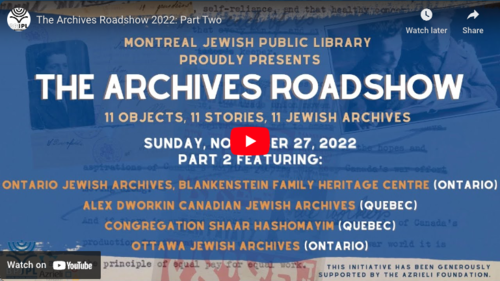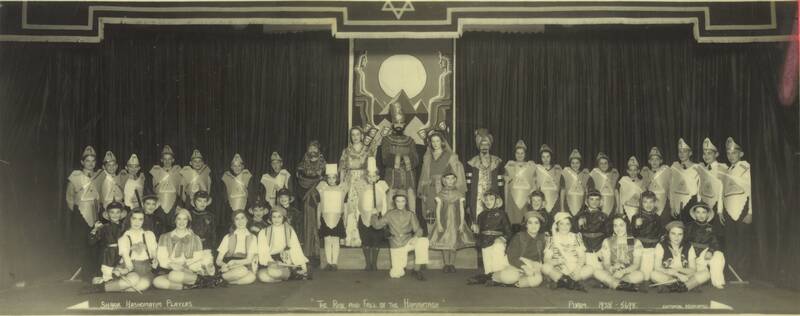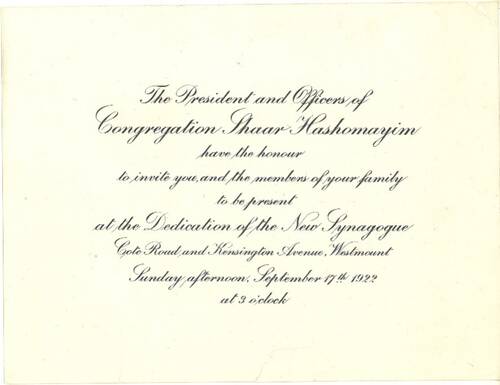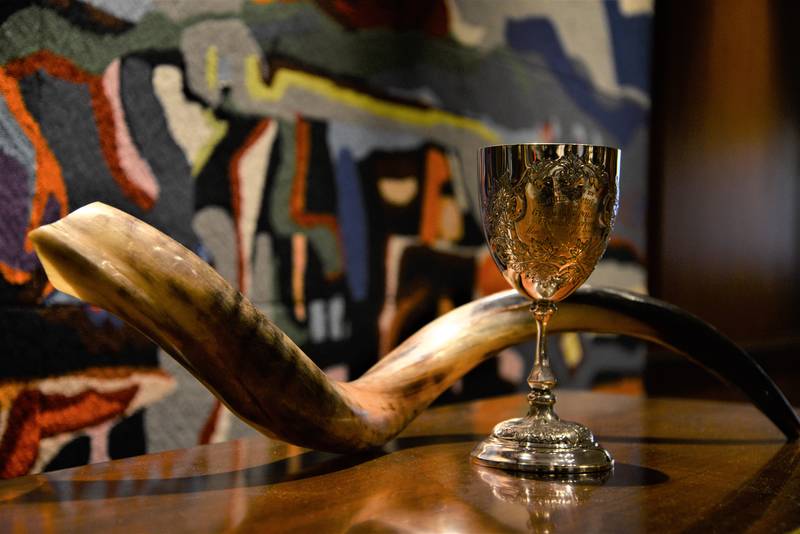A Look Through our Archives
Remembrance Day 2023 – Remembering Rabbi Dr. Samuel Cass
BY HANNAH SROUR-ZACKON
| Author | |
| Date Added |
With Remembrance Day around the corner, this week we pay tribute to a member of our community- Rabbi Dr. Samuel Cass z”l—who served as army chaplain to Canadian Jews in World War II and was for many years the Rabbi of the community hall service at the Shaar.
Born in Toronto, Rabbi Cass gradated from the Jewish Theological Seminary in 1933 after which he served congregations in Vancouver and Seattle before World War II. He would also occasionally substitute for Rabbi Herman Abramowitz at the Shaar during the latter’s summer vacation. His relationship to the Shaar was cemented when he married Annabel Goldfine who was also of the synagogue’s community.
In 1942, Rabbi Cass along with Rabbi Gershon Levi (a past educational director of the Shaar) were named as the two full-time Senior Jewish Chaplain to the Canadian Armed Forces, with Rabbi Cass stationed at home. Later, in 1944, Rabbis Cass and Levi swapped positions, and Rabbi Cass was sent overseas. Among his many services to Jewish soldiers, he oversaw religious services and holiday celebrations. In 1944, he organized a Chanukah party in Antwerp for soldiers as well as for 250 local children.
In 1945, he organized a seder in Brussels.
In March of 1945, he held a service in Kleve, Germany outside the Reichswald Forest – which in February of that year had been the site of the Battle of the Reichswald fought by Canadian and British forces (allied victory). Following this Battle, it became the site of the largest Commonwealth cemetery in Germany.
Rabbi Cass’ service was to make its mark beyond his chaplaincy services to Canadian soldiers – in that same year, he was the first Jewish chaplain to enter concentrations camps which were liberated by the Canadian Army and played an instrumental role in rehabilitating the survivors, and in helping Belgium and Dutch Jewry.
After the War, he was honourably discharged with the rank of Major and would then go on to work for many years as the Director of Hillel before his tragic death in 1975.
Further Reading
Rabbi Herman Abramowitz and Jewish Chaplaincy Services During World War II
In Tribute to Yehouda Chaki z”l
BY HANNAH SROUR-ZACKON
| Author | |
| Date Added |
Early last month, prominent Canadian Jewish artist Yehouda Chaki z”l passed away at the age of 84. Among the many wonderful contributions to art in Canada, Chaki, a long-time member of our own Shaar community, was behind the design of the two beautiful tapestries sewn by the Sisterhood, depicting scenes from Bereshit, which hang in our building. This week, as we begin another Torah reading cycle on Simchat Torah, we pay tribute to Yehouda Chaki and the two tapestries.
In The Beginning
The first Chaki-designed tapestry “In The Beginning” was unveiled by the Sisterhood in 1982 and took two and a half years to complete. In the fall of that year, at the reception preceding the Slichot services, the Sisterhood sponsored a vernissage of the tapestry as part of the Westmount Arts Festival. This was the first public viewing of the tapestry, and was attended by guests and officials of the City of Westmount along with Sisterhood members who made squares in the tapestry and Yehouda Chaki himself.
Let There Be Light
In 1992, in time for the Congregation’s 145th anniversary, the Sisterhood unveiled its second needlepoint tapestry designed by Yehouda Chaki titled, Let There Be Light . This was another great undertaking by members of Sisterhood who each completed squares of the tapestry. The Committee for this project was chaired by Mildred B. Lande, C.M., and Carol Koffler.
Further reading on Yehouda Chaki
Brownstein: Chaki was one of Canada's most prominent and prolific artists
Obituary: Yehouda Chaki, 84, expressed both joy and pain in his vibrant paintings
Remembering the Yom Kippur War, 50 Years Later
BY HANNAH SROUR-ZACKON
| Author | |
| Date Added |

“Yom Kippur will never be the same again,” begins a message written by Rabbi Wilfred Shuchat in 1973. This year we mark the 50th anniversary of the outbreak of the Yom Kippur War, one of the greatest threats to the State of Israel since its independence in 1948. There to bear witness to the conflict was none other than Rabbi Shuchat, who wrote back messages to the Congregation as it unfolded (full letters at the end).
Rabbi Shuchat was honoured with a sabbatical soon after celebrating 25 years with Shaar Hashomayim and went with his family to spend the year (from July 1973 through the summer of 1974) in Jerusalem. Though Rabbi Shuchat returned to Montreal for Rosh Hashanah and Yom Kippur, he went back to an Israel embroiled in war.

The words Rabbi Shuchat wrote in his messages to the Congregation as the Yom Kippur War progressed deeply reflect the severity of the situation, while also foreseeing its lasting impact and significance. “For the past two weeks I have been living in the very center of those dramatic events that will determine Jewish history for the future and will certainly have a momentous effect upon the course of the world.”

Writing on October 23rd, 1973, just two days before it officially came to an end, Rabbi Shuchat offered three conclusions to be drawn from the War as Israel, the Jewish Diaspora, and the world moves forward, the third of which is a resounding and heartfelt declaration of the bond between Israel and the Diaspora as one Jewish people.
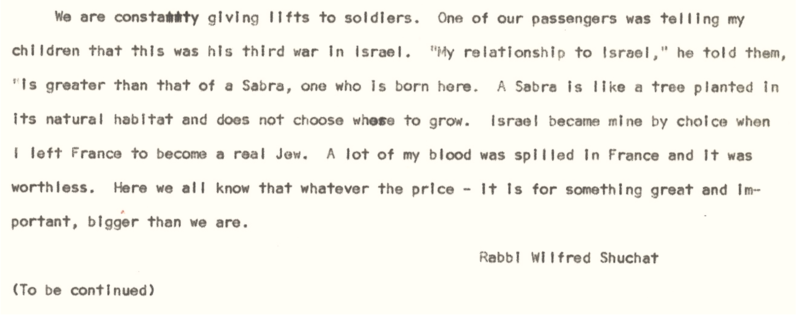
READ: A message from Rabbi Shuchat, War Letter from Israel
Back to School – The Rabbi Herman Abramowitz Educational Annex
BY HANNAH SROUR-ZACKON
| Author | |
| Date Added |
This Fall will mark 75 years since the Rabbi Herman Abramowitz Building (Educational Annex) was formally dedicated. As we gear up for back-to-school we’re looking back on the day the school building was officially opened.
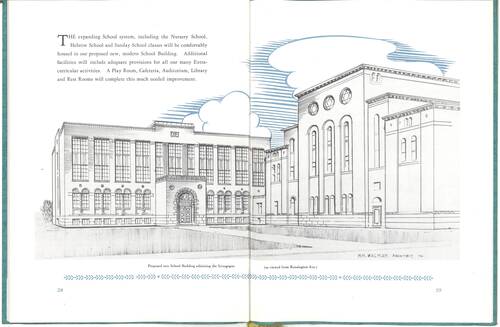
The educational centre was a longtime the goal of Rabbi Herman Abramowitz, who was a strong advocate for Jewish education. In the years leading up to it’s opening, the Shaar’s Westmount building (which had been built just 26 years prior) was already bursting at the seams and the need for additional space for the synagogue’s educational activities was abundantly clear. While World War II did delay progress, by the time the Shaar’s centennial year in 1946-7 the necessary funds were secured.
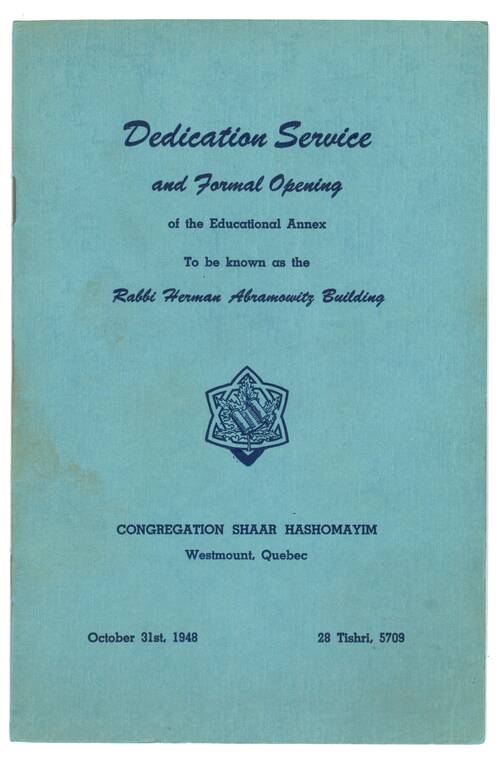
On October 31, 1948, the building officially opened following a beautiful dedication ceremony during which then Shaar President Moses J. Heillig was presented with a commemorative silver trowel.
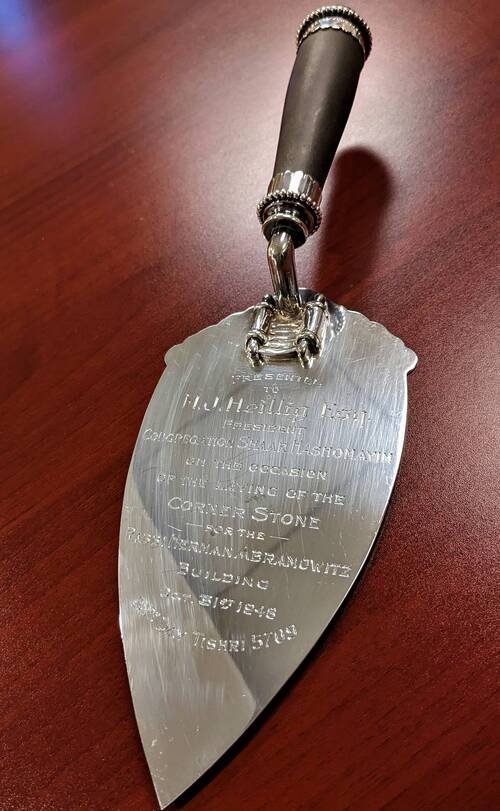
(The trowel reads: Presented to M. J. Heillig, Esq. President of Congregation Shaar Hashomayim on the occasion of the laying of the Corner Stone for the Rabbi Herman Abramowitz Building. Oct. 31st 1948. 23rd Day Tishrei 5709)
Unfortunately, Rabbi Abramowitz would not live see the building’s completion as he passed away after a long illness in October 1947. However, his legacy of dedication to Jewish education as the building was dedicated in his name.
Stained Glass Window
BY HANNAH SROUR-ZACKON
| Author | |
| Date Added |
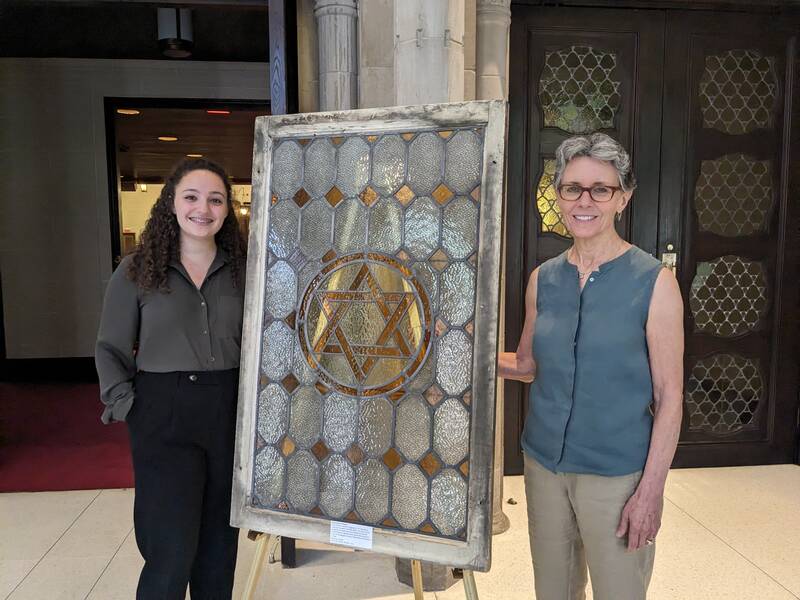
It’s been a very interesting week for us at the Shaar Archives and Museum! On Monday, we were visited by Simcha Shtull, who is in Montreal filming a documentary about the stained-glass windows of the old Shomrim Laboker synagogue building on St. Dominque, one of which is in the Shaar’s Museum collection. For the documentary, our archivist Hannah Srour-Zackon was interviewed about the window, the history of the Shaar, and the importance of preserving Jewish history.
The Shtull family purchased the Shomrim Laboker building in the 1950s (when the synagogue moved to Plamondon and Westbury) and used it for their egg and butter distribution business. When the business closed, the stained-glass windows all ended up in different places. For the documentary, Simcha Shtull is tracing the journey of each of the windows. We are so excited to be a part of this story and look forward to seeing the documentary when it’s finished!
Meet our summer Archives Assistant!
by Molly Lohner
| Author | |
| Date Added |
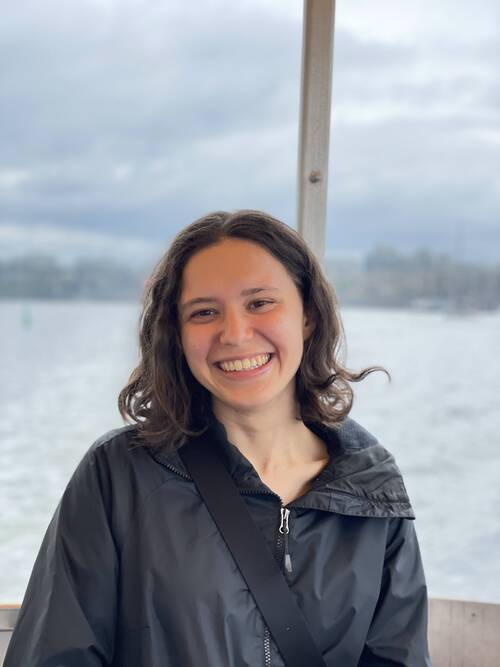
Hi everyone! My name is Molly Lohner and I will be your Archives Assistant this summer. I was born and raised in Montreal and I just graduated from McGill with a Bachelor of Arts in History and a minor in Philosophy. This summer I am also working as a tour guide leading the Museum of Jewish Montreal’s Beyond the Bagel food tour, which explores historic and modern Jewish food businesses in the Mile End. As a Montreal Jew, I have always been curious about what life was like for this community in decades past. I feel so lucky to get to investigate this history as part of both of my jobs this summer.
What will I be doing?
As Archives Assistant, my role is to help the Archivist, Hannah, with various archiving tasks. So far, I have been writing blog posts and going through a box of papers from Rabbi Abramowitz. I am also excited to start helping to curate material for the museum.
What have I found so far?
Rabbi Dr. Herman Abramowitz was the Rabbi of the congregation from 1902 to 1947. He was recruited shortly after he graduated with a doctorate and a rabbinical ordination from the Jewish Theological Seminary, the rabbinical school associated with the Conservative movement.
I was surprised to find how much material in his box was related to the education programs that took place at the Shaar. He seems to have been very passionate about the Jewish value of educating one’s children and dedicated much of his time to overseeing the afternoon Hebrew school and Sunday religious school.
I have also been fascinated by the material related to the Rabbi’s chaplaincy work. He was a chaplain for the Jewish Canadian members of the British forces during the First World War; during the Second World War, he chaired the committee that appointed Jewish chaplains for the Canadian forces.
School Graduations Through the Years
by Molly Lohner
| Author | |
| Date Added |
As we approach the end of June, students of all ages are celebrating graduations from elementary schools, high schools, CEGEPs, and universities. Throughout the years the Shaar has hosted various ceremonies of this kind and I will highlight a few of them in this post.
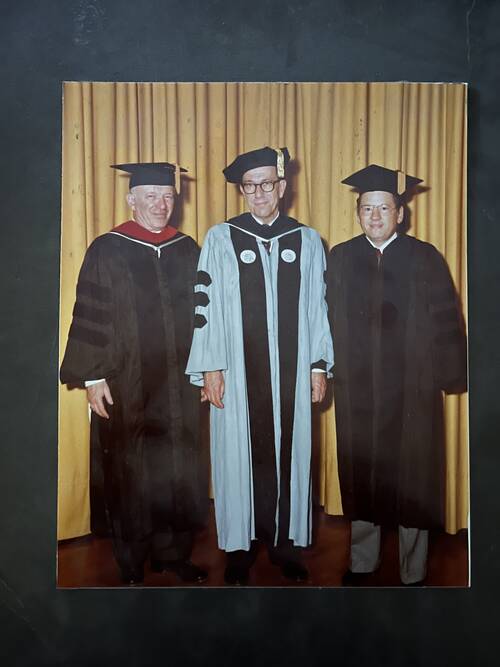
This picture shows, from left to right, Rabbi Wilfred Shuchat; Rabbi Dr. Louis Finkelstein, chancellor of the Jewish Theological Seminary; and Nahum Gelber, honorary past president of the synagogue. It was taken at the JTS convocation that the Shaar hosted on April 23, 1972, as part of the 125th anniversary celebrations of the congregation. At this ceremony, His Excellency the Right Honourable Roland Michener, Governor General of Canada, received an honorary Doctor of Laws from the JTS chancellor. It also featured Saidye Bronfman and Hon. Lazarus Phillips becoming fellows of the JTS Society of Fellows. Over a thousand people attended this ceremony, as can be seen in the picture below.
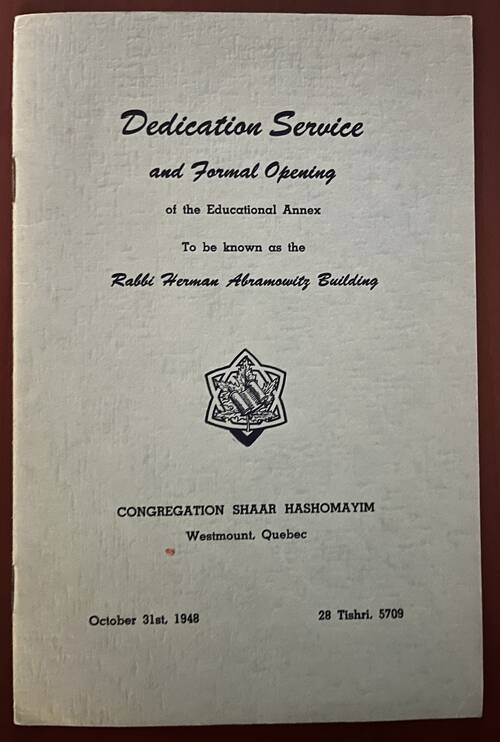
The above picture is a program from the dedication service of the Rabbi Herman Abramowitz Building which functioned as an Educational Annex. It now houses Akiva School but used to be a Sunday and afternoon Hebrew school administered by the Shaar. The congregation decided to build this annex, which was dedicated in 1948, to expand the size and increase the quality of the synagogue’s educational space.
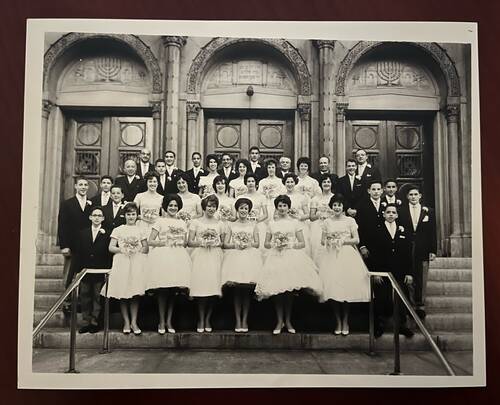
These pictures are of the graduating classes of the Hebrew school from 1931 and 1960 (donated recently by Ron Vineberg), respectively. The graduates would have been around fifteen and had the option to continue attending classes at the Shaar during their high school years. You can find lots more of these graduation pictures up along the walls in the synagogue building today.
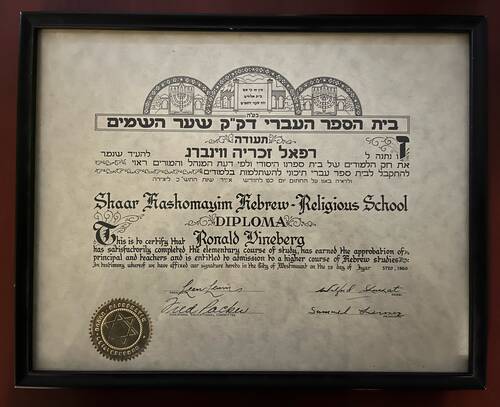
The above image is the diploma of Ronald Vineberg, a former student at the Hebrew school and lifelong member of the congregation. This is one of many documents kindly donated by Ron Vineberg to the synagogue’s archives which are helping to fill gaps in our collection.
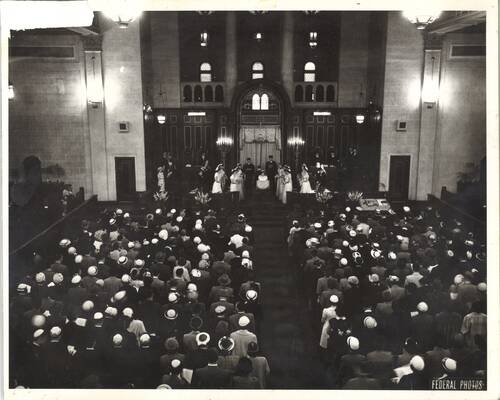
Here we can see an image from a Hebrew school graduation ceremony from sometime in the early twentieth century.
Wedding Season at the Shaar
by Molly Lohner
| Author | |
| Date Added |
It’s wedding season! As we get ready to celebrate the rush of weddings this summer, let’s look back at some Shaar wedding celebrations from the past century.
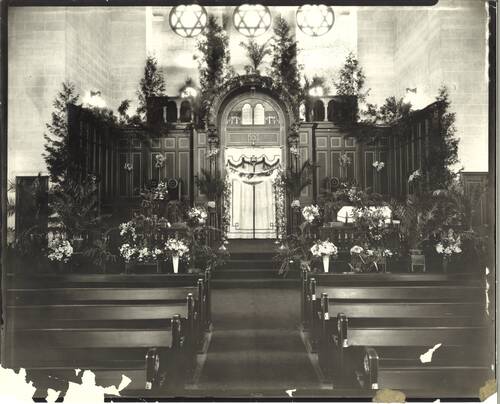
The congregation dedicated its current sanctuary in 1922 after leaving its second building on McGill College Avenue. The above image shows the sanctuary decorated for a wedding in the 1920s, making it one of the first weddings held in this building.
In 1953, in an effort to increase recently married young women’s involvement in the congregation, the president of the Women’s Auxiliary instituted annual bridal teas. All the brides married that year would gather to meet the women of the Auxiliary and the inner family of the synagogue. This image shows a bridal tea hosted by Saidye Bronfman in 1954. The initiative was successful, resulting in many young women joining the Auxiliary.
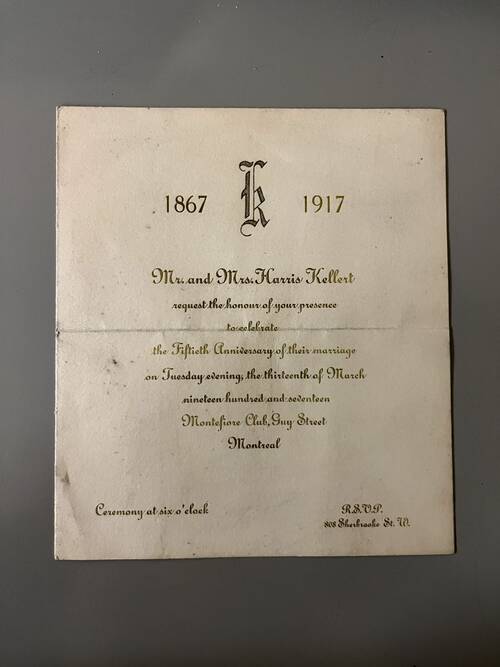
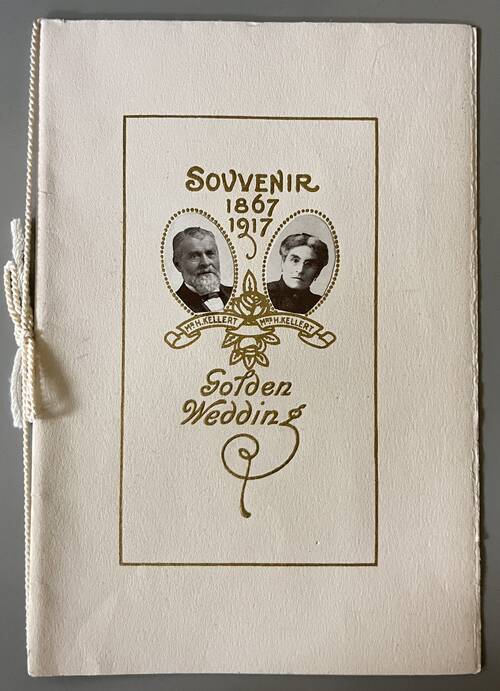
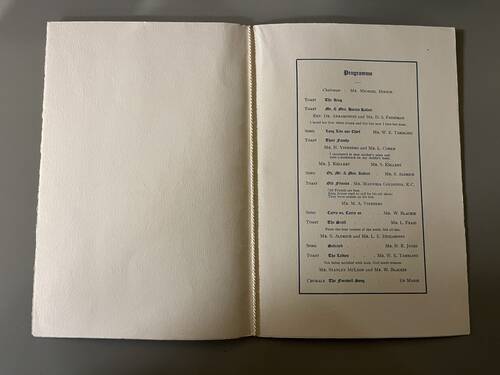
This invitation and souvenir program are from the golden wedding anniversary of involved members of the congregation Harris Kellert and Esther Matts. Married in 1867, they held their 50th anniversary at the Montefiore Club in 1917. The event was chaired by Michael Hirsch, who was a prominent philanthropist, lifelong Shaar member, and one of the founders of the Montefiore Club. It also included toasts by Rabbi Dr. Herman Abramowitz, Lyon Cohen, and family members and friends of the couple.
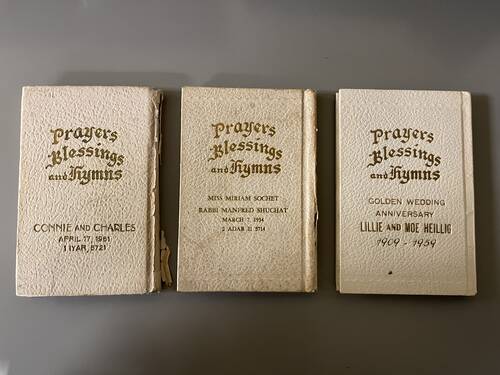
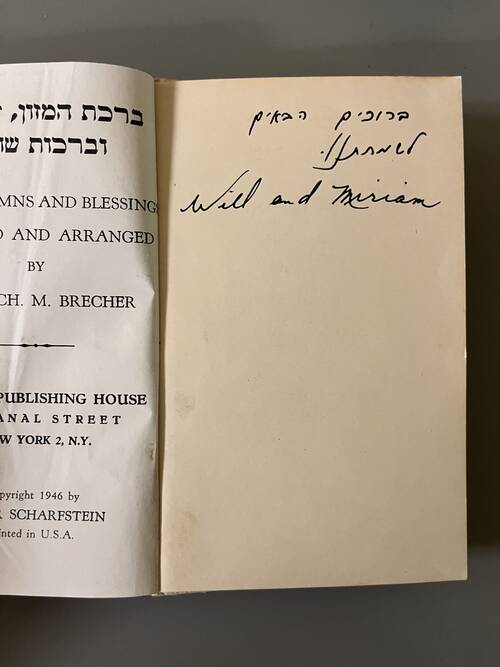
These three benchers celebrate Shaar couples in different ways. The one on the far left is from the wedding of Connie and Charles Solomon. The one on the far right is from the golden anniversary of Lillie and Moe Heillig, also lifelong active members of the congregation. The one in the middle is from the wedding of Miriam Sochet and Rabbi Wilfred Shuchat, the Shaar’s rabbi from 1946 to 1993. You’ll notice that Rabbi Shuchat’s first name was misprinted on his own wedding bencher! As pictured beside these, the couple signed the inside of the bencher with their real names, Will and Miriam.
A Yemenite Manuscript Book of Haftarot
Hannah Srour-Zackon
| Author | |
| Date Added |
On Shavuot, we celebrate the receiving of the Torah – the Book of Books, the source of the Jewish People’s designation as the ‘People of the Book’. It is fitting, then, that the Shaar has a wonderful collection of rare books in our collection. Among them is one particularly fascinating book: A handwritten manuscript book of haftarot produced in Yemen in the early 19th C.
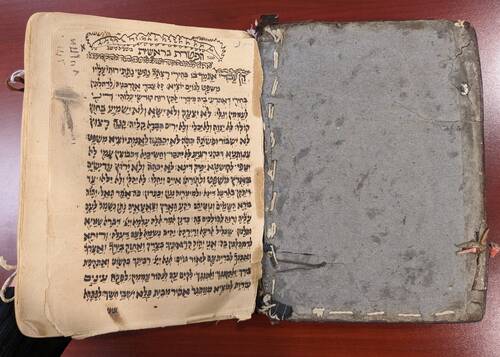
The first page of the manuscript book.
Little is known about this fascinating volume – we don’t know anything about its scribe nor what year it entered the collection. The hand of the scribe, with its occasional unevenness and ink smudges, suggests a true human quality to each production. Each haftarah begins with an embellished title, indicating a new section. Note also that each page ends with the word to look for on the following page. The following pages show the haftarot we will read on Shavuot.
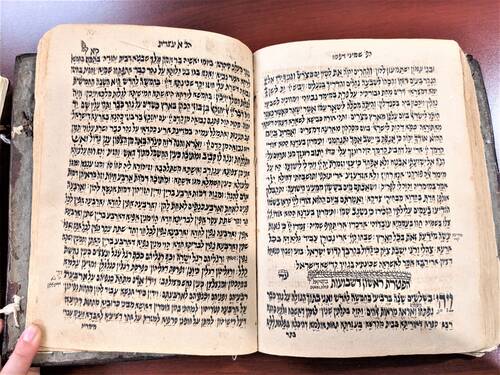
Shavuot haftarah, 1
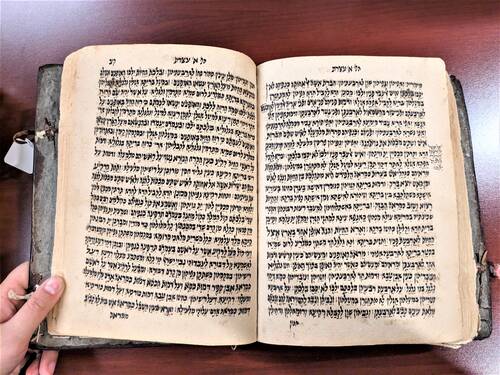
Shavuot haftarah, 2
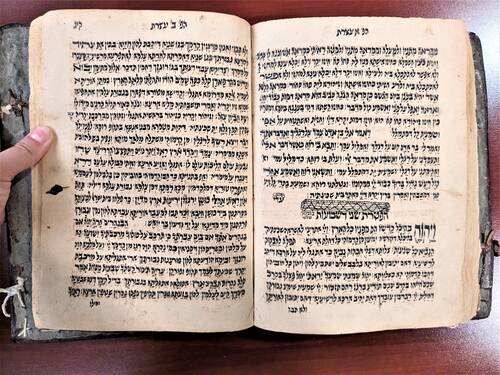
Shavuot haftarah, 3. The haftarah for the second day of Shavuot begins midway down the page on the right.
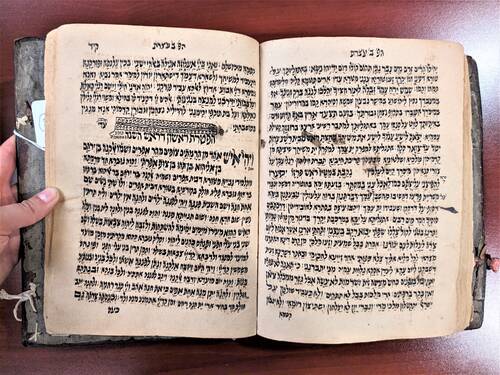
Shavuot haftarah, 4
The Shaar Archives & Museum Receives Investment to Develop Online Exhibit
| Author | |
| Date Added |
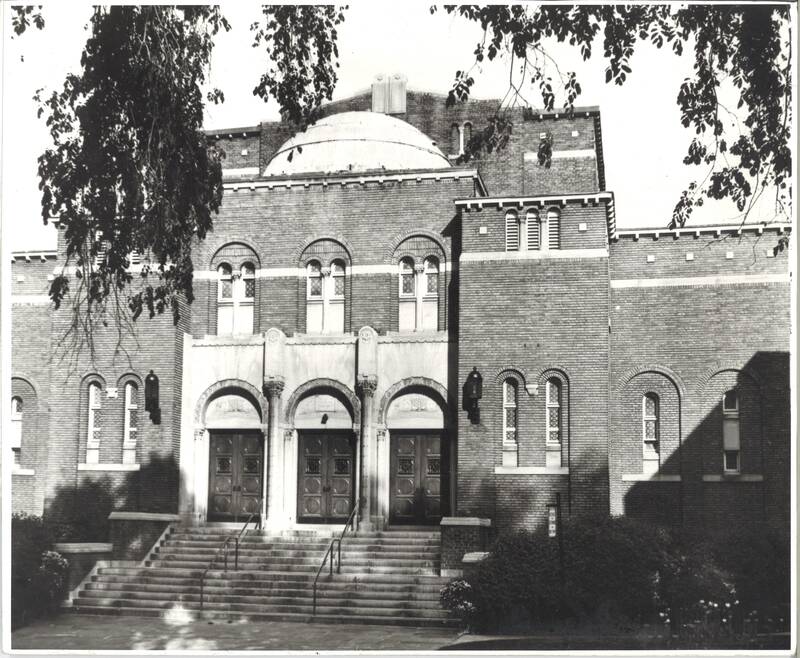
The Shaar Archives & Museum Receives Investment to Develop Online Exhibit
The Shaar Hashomayim Archives & Museum is delighted to share—just in time for Canadian Jewish Heritage Month—that we have been chosen as a recipient of an investment from Digital Museums Canada (administered by the Canadian Museum of History) to develop an online exhibit celebrating 100 years of the Shaar in Westmount. Among the many exciting aspects of this project include that it will be bilingual, increase our outreach in the digital sphere, and will boost the profile of our synagogue’s long & fascinating history as the virtual exhibit will be hosted on the "Community Stories" platform run by Digital Museums Canada. You can read the official news release here and read more about the Community Stories platform here.
The Digital Museums Canada (DMC) investment program helps build digital capacity in Canadian museums and heritage, cultural and Indigenous organizations, and gives people living in Canada unique access to diverse stories and experiences. DMC is managed by the Canadian Museum of History, with the financial support of the Government of Canada.
Israel at 75: Celebrating the Shaar’s long connection with Israel
| Author | |
| Date Added |
Beginning in the evening on April 25th, Israel will be marking its 75th year since Independence. On this milestone occasion, we are celebrating the close connection between the Shaar and Israel--which dates back to long before the establishment of the State. In this digital photo gallery, see how the Shaar has celebrated, marked, and memorialised important moments in Israeli history, both in Israel and in Canada, beginning in 1912.
As we celebrate Israel's 75th, the Shaar Museum and Archives wants to see your Shaar/Israel memories! Do you have an photographs, papers, or other documents from across the years? If so, please get in touch with us at museum@theshaar.org
USE YOUR ARROW KEYS TO SCROLL THE PHOTOS
A Small Seder Plate with a Fascinating History
BY HANNAH SROUR-ZACKON
| Author | |
| Date Added |
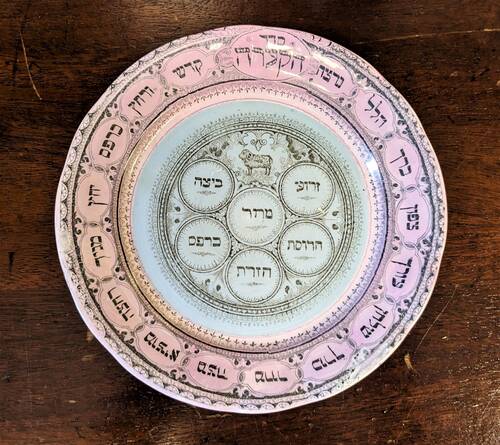
This small ceramic seder plate (c. 1895), with a pale pink rim and blue centre, has a fascinating history. It was originally donated to the Shaar’s museum by Jeanie Rosemarin (the sister-in-law of long-time Shaar music director Prof. Jacob Rosemarin) in 1987, and it was brought over from Eastern Europe by her parents. Aside from its beauty, a mark on the back of the plate gives a major clue to its history…
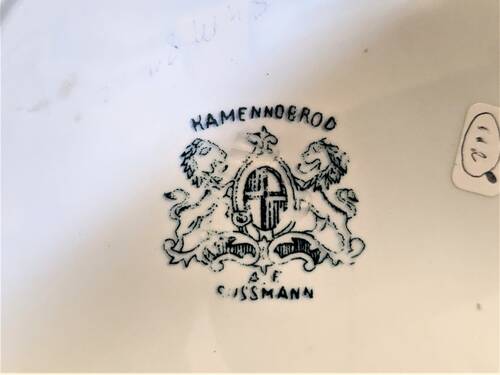
On the back is written “Kamennobrod – A.F. Sussman”. With a bit of research, this indicates it was made at the faience (fine tin-glazed pottery) factory in Kamenny Brod (modern-day Ukraine).
Kamenny Brod only began to develop in the second half of the 19th century—during which time the factory was established. Towards the last quarter of the 1800s, ownership of the factory was taken over by the Sussman family, who developed it into the largest faience factory in the region. This attracted a number of Jews to move to the town. Indeed, the factory quickly became the economic heart of the town, employing much of the local population.

Under Aizik (A. F.) Sussman's leadership, the factory gained a reputation for its beautiful craftmanship. Sussman brought the factories’ best pieces to international exhibitions such as in Poltava (1895), Odessa (1897), and Kyiv, where they won numerous awards.
This seder plate may just be a mere snippet of a long history, but it offers a window to the past, and its presence in the Shaar’s museum collection offers a chance to connect with this history.
The seder plate is currently on display outside of the Shaar’s main office. If you're interested in reading more about Kamenny Brod and its faience factory, an excellent and detailed history is available at the below links:
Sources:
https://kehilalinks.jewishgen.org/kamennyy_Brod/history-faience_factory.htm
https://kehilalinks.jewishgen.org/Kamennyy_Brod/KamennyyHistory.pdf
The Ya’akov Boussidan Haggadah
| Author | |
| Date Added |
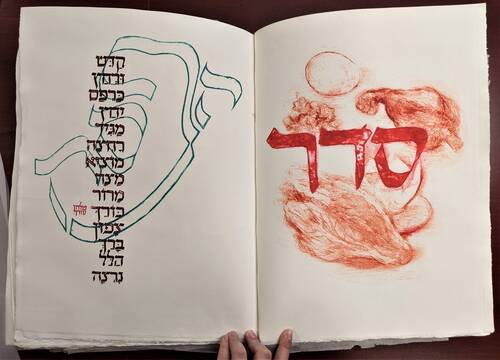
The Haggadah has a history of not only being one of the most produced Jewish books (with some estimates citing more than 5,000 published versions), but one of the most beautifully decorated as well. The tradition of artfully produced Haggadot dates back to the medieval era (13th century) when such Haggadot as the Golden Haggadah and the fascinating Birds’ Head Haggadah. This tradition has continued into even recent years with the emergence of artist’s books Haggadot. The Shaar Hashomayim Museum and Archives is proud to have one such Haggadah in our collection: the Ya’akov Boussidan Haggadah.
Ya’akov Boussidan is an Israeli artist who, born in Port Said, Egypt, came to Israel with his family in 1949 as a child. His works have been acquired by such places The Victoria and Albert Museum in London, The Metropolitan Museum of Art in New York, The Boston Museum of Fine Arts, and the Israel Museum in Jerusalem.
Among the many works Boussidan has produced, in the 1970s he undertook a project to create his own Haggadah. These Haggadot took several years to make in Boussidan’s London-based studio and include 30 colour etchings. An interesting aspect of Boussidan’s Haggadah is the incorporation of the story of creation from Bereishit.
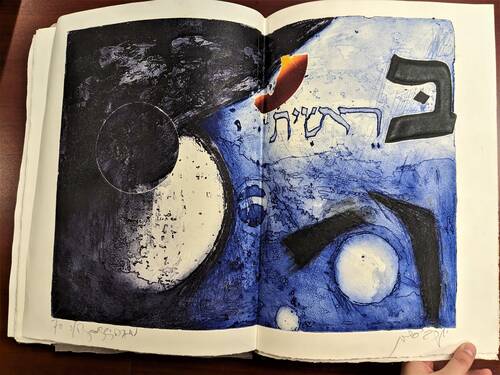
The Haggadah was finally finished in 1975 and it is a breathtaking work of art. There are merely 60 copies in the whole world. As noted in the etchings in the book, the copy in the Shaar’s museum collection is number 10, and was gifted in 1981 by Dr. and Mrs. William Cohen.
If you are interested in seeing the Haggadah in person, please reach out to museum@theshaar.org to make an appointment.
Further Reading:
The Purimspiel of 1954: Original Costume Sketches
BY HANNAH SROUR-ZACKON
| Author | |
| Date Added |
The Shaar’s tradition of elaborately produced Purimspiels put on by the youth of the synagogue carried on for decades. This week we’re featuring some of the original costume sketches from the Purimspiel of 1954, “Hopalong Haman Rides Again”
This Purimspiel—which was a parody of the 1937 Western Hopalong Rides Again was performed Thursday March 18th on Erev Purim.

Among the cast members included Rebecca Mendelson as Esther, Rita Blitt as Vashti, Lorne Mendel as Mordecai, Jeffrey Weissler as Haman, and Jacob Elkin as Ahasuerus.
The costume sketches which you’ll see below are the original renderings. Each kid was dressed in appropriate ‘cowboy’-themed costumes to go with the theme of the Purimspiel.
Esther:
Vashti:
Mordecai:
Haman:
King Ahasuerus:
The Purimspiel of 1939: “Purim in Persia”
| Author | |
| Date Added |
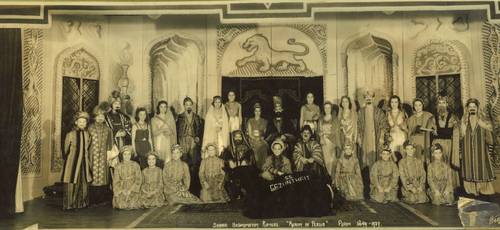
Last year, The Shaar Hashomayim Museum & Archives rediscovered a treasure trove of photographs from past Purim celebrations at the Shaar. Among these photographs were several large and fascinating cast pictures from the elaborate Purimspiels the youth of the synagogue would put on every year.
This week we’re featuring the Purimspiel of 1939: Purim in Persia.
As reported in the Canadian Jewish Chronicle on March 3rd of that year, the Purimspiel, directed by Mr. Samuel Lerner, was to be performed on Sunday March 5th and was the highlight of the synagogue’s annual Purim banquet. The musical was based on a script written by Moshe Davis—an American rabbi who taught for many years at both the Jewish Theological Seminary and at the Hebrew University.

Here is how the paper reported the production prior to its performance:
“‘Purim in Persia,’ a musical comedy in two acts and five scenes, adapted by Mr. S. Lerner, from the script of Moshe Davis, will be the main feature of the Eleventh Annual Purim Banquet at the Shaar Hashomayim Synagogue next Sunday evening, March 5th, at 6 pm.
The cast of the play includes Horace Baittle, Mindel Bronfman, Neil Phillips, Lazarus Cohen, Edward Levinson, Leslie Brodkin, Bernard Berlin, Ian Lemco, Samuel Getz, Peter Rosenbaum, Edgar Wener, Sheila Abbey, Reva Leibovich, Gordon Edelstone, Marilyn Block, Sybil Freedman, Peter Bronfman, Edgar Bronfman, David Lemco, Donald Kirk, Billy Levy, Allan Kirsch, Perry Meyer, Anita Elkin, Katherine Silver, Florence Gersovitz, Wylma Jacobs, Naomi Pressman, Selman Schachter, Joyce Lozinski, Arthur Victor and Alan Finestone.
The play is under the direction of Mr. S. Lerner, with the music provided by Mrs. N. Fineberg. Fred Solomon is stage manager.”
In the following week’s issue of the Canadian Jewish Chronicle, it was reported that the production was so popular that it would be perform an encore performance the following Sunday (March 12th)
Sources:
1. https://news.google.com/newspapers?nid=2Q0AJrNhS-QC&dat=19390303&printsec=frontpage&hl=en
2. https://news.google.com/newspapers?nid=2Q0AJrNhS-QC&dat=19390310&printsec=frontpage&hl=en
Presenting the 1948 Cornerstone Trowel
BY HANNAH SROUR-ZACKON
| Author | |
| Date Added |
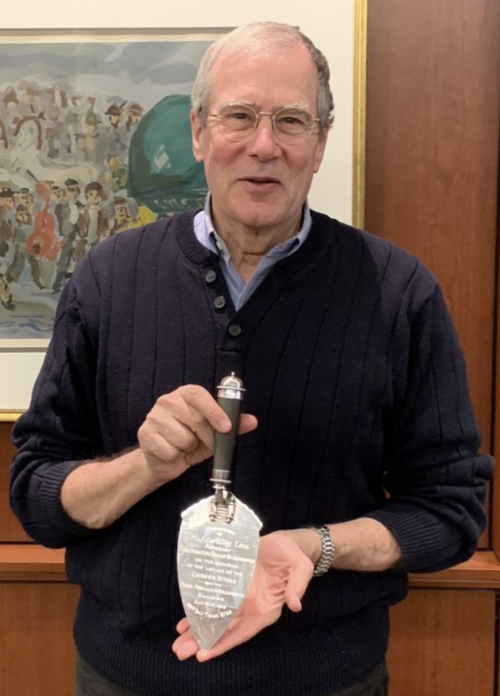
Towards the end of 2022 the Shaar Hashomayim Museum and Archives received a most fascinating gift: Charles Kaplan (pictured above), reached out to offer the commemorative silver trowel to his grandfather—Past Shaar President Moses Jacob (M. J.) Heillig z”l—on the occasion of the laying of the cornerstone of the Rabbi Herman Abramowitz Educational Annex on October 31, 1948. We were, of course, delighted to reencounter this important artifact of the Shaar’s history.
The Trowel in Focus
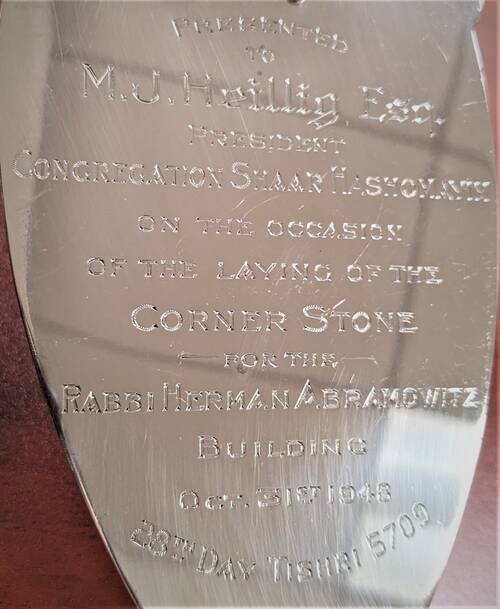
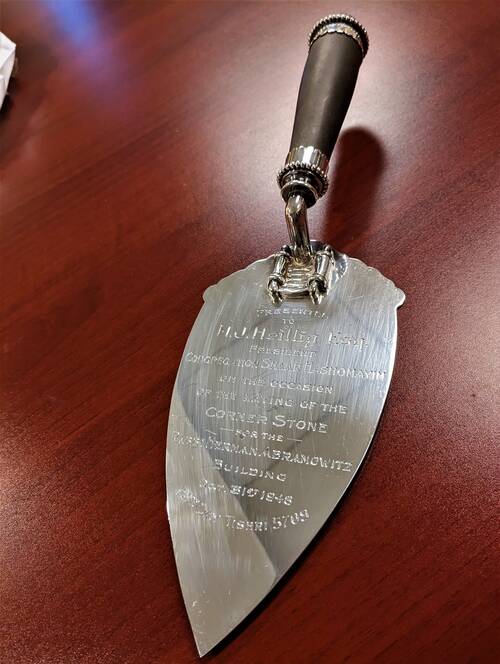
The silver trowel is similar in design to those already in the museum’s possession from other cornerstone-laying occasions in the synagogue’s history. It is engraved with the following message:
Presented to M. J. Heillig, Esq. President of Congregation Shaar Hashomayim on the occasion of the laying of the Corner Stone for the Rabbi Herman Abramowitz Building. Oct. 31st 1948. 23rd Day Tishrei 5709.
At the base of the handle where it meets the silver plate is a small figure of an open Torah scroll.
Who was M. J. Heillig?
Moses Heillig served as the president of the synagogue from 1947-1956, but these years merely represent a fraction of the many years in service to the Shaar. In fact, Heillig’s years in uninterrupted service to the Synagogue total well over a half century, making him the longest serving member in the history of the synagogue. Beginning when he was merely in his early twenties, he became the secretary of the synagogue and would go on to serve as vice-president, president, honorary president, and as chairman of Cemetery Committee from 1945 for many decades.
What happened during the cornerstone laying ceremony?

On November 5, 1948, the Canadian Jewish Review reported the following:
The newly-constructed educational annex, to be known as the Rabbi Herman Abramowitz Building was dedicated and formally opened, the Rabbi and Cantor Nathan Mendelson officiating, with the choir under the direction of Jacob Rosemarin, with Mrs. M. N. Fineberg at the organ. The Ark was opened by Ronald Cape, president of the Junior Congregation, Horace R. Cohen, O.B.E, honorary president of the congregation, presided. Greetings were extended on behalf of Mayor R. P. Adams of Westmount by Alderman G. L. Fowler. The Montreal Protestant School Board was represented by its chairman, W. E. Dunton, and the Westmount Board of School Commissioners by C. H. Savage. The cornerstone was placed by M. J. Heillig, the president, and the formal presentation of the building was made by Max Finestone, chairman of the Building Committee, to Philip Lev, chairman of the Education Committee. The educational director, Samuel L. Leibowitz affixed to the doorpost the traditional mezuzah. Junior congregation simchas Torah Hakofos were conducted at evening and morning services by the officers and cantors, Ronald Cape presided; Arthur [obscured] acted as parnass; David cape as [obscured]; and Morton Schwartz read from the Torah. The Ark was opened by Lewis Batshaw and Leonard Cohen. Participants were: Howard Bacal, Harold Shapiro, Perry Meyer, Bernard Cooper, Joseph Mendel, Mark Shapiro, Mark Bercuvitz, Basil Ballon, Daniel Usher, Arthur Freedman, Jerry Freedman, Jerry Kurland, Harvey smith, Robert Feldstein, Murray Notkin, Haskell Zabitsky, Avrum Bloomstone, Allan Bernfeld, Charles Solomon, Marvin Goldsmith, Bernard Shapiro, Martin Goodman, Harold Scherzer, Ronald Gallay.”
We express our sincerest gratitude to Mr. Kaplan for his wonderful gift which will be preserved among the history of our synagogue in perpetuity.
The Shaar Men’s Choir
BY HANNAH SROUR-ZACKON
| Author | |
| Date Added |
Congregation Shaar Hashomayim is one of the few remaining synagogues in the world to maintain, on a weekly basis, the traditions of the great Choral Synagogues of Europe. The services are focused on the chanting of the Cantor, who is accompanied by an all-male choir dating back to 1887. Both the Cantor and choir sing at all Shabbat and festival services. The music is a seamless blend of traditional prayer modes (nuscha’ot), compositions for choir and cantor (traditional and contemporary), music for choir alone, and congregational melodies.
The Shaar Hashomayim Synagogue Choir is a highly regarded all-Jewish, all-male ensemble. The Choir sings on Shabbat, festival, and High Holy Day Services throughout the year. The method of arrangement and broad harmonic palette, combined with the style of singing, produces a very distinctive sound that has been widely praised. Much attention is paid to blend and balance, creating an especially elegant choral sound. While the choir sometimes sings compositions on its own, much of the time it provides a sophisticated a cappella harmonic accompaniment to the Cantor’s vocal line.
As we mark our annual Shabbat Shirah service, the Shaar Hashomayim’s Musem and Archives has launched a new display celebrating the synagogue’s choir over the years.
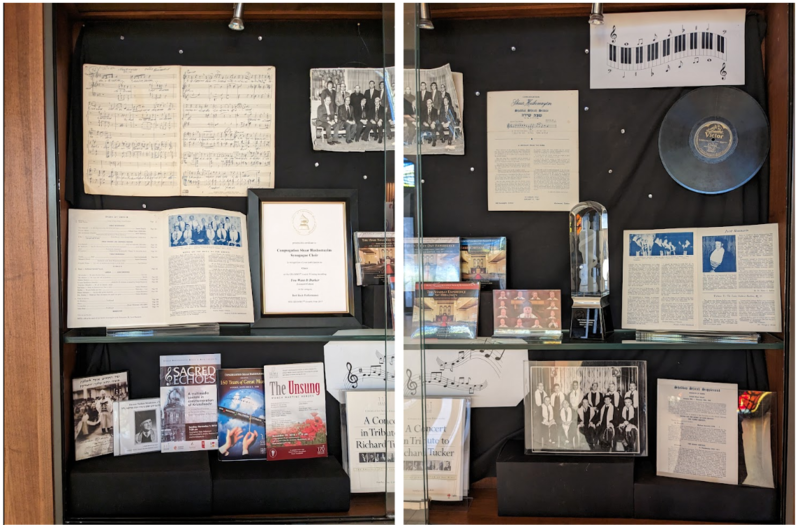
The Shabbat Shirah service became a fixture during the 1950s. In Gate of Heaven: The Story of Congregation Shaar Hashomayim of Montreal, Rabbi Shuchat writes the following:
The appointment of Isidore Ballon as chairman reinvigorated the Choir Committee...An important development was the transformation of Shabbat Shirah (the Sabbath of Song), which commemorates the Song of Moses, into a Sabbath liturgical concert. The thought behind it was explained by Cantor Nathan Mendelson in a column he published in the Bulletin of 8 February 1952: “It is not our intention to completely change the elements of our music for this Sabbath. Regular worshippers will find the service basically the same, with the addition of several especially prepared selections, some of which will be heard for the first time. Yet it is apparent to the regular shul-goer that the Annual Shabbos Shiroh innovations have also influenced our weekly service, for the additional repertoire thus made available is employed from time to time to add a refreshing note to our Sabbath prayers.” (184-5)
Over the course of the Shaar’s history, the synagogue’s choir and music have been led by several talented music directors, each of whom have left their musical mark on the synagogue until this day. These include the synagogue’s two longest serving music directors: Professor Jacob Rosemarin (music director from 1942-1972) and Stephen Glass (1990-2014), whose many beautiful signature musical and choral arrangements have brought our synagogue’s services to new heights and can be heard throughout the Jewish liturgical world.
Click here for some of our Shaar favourites as performed by our Shaar Hashomayim Choir.
Archives Roadshow - Part Two
| Author | |
| Date Added |
Thank you to all those who tuned in on November 27th for the very well-attended Archives Roadshow (Part Two)! If you were unable to make it, the recording of the event is now available. In this program, you will learn about four Jewish archives in Canada, and about one fascinating item in our own synagogue archives which sheds light on an important part of our synagogue’s history and our contributions to Canadian Jewish history!
Jewish Book Month
| Author | |
| Date Added |
The origins of Jewish Book Month in North America can be traced back nearly 100 years to librarian Fanny Goldstein in Boston who first curated a display of Jewish books to encourage the purchasing of books are Chanukah gifts. The Shaar too, for many years, has taken part in Jewish Book Month festivities, events for which were largely organized by the synagogue’s Sisterhood.
This picture shows Libby Bernfeld with a Jewish Book Month display at the Shaar in November 1955. The sign behind her reads “Jewish books help create the home which is Jewish and Beautiful”.
Services of Remembrance for our Veterans, in 1924 and 1945
| Author | |
| Date Added |
Services honouring our congregation’s veterans have long been a part of the Shaar Hashomayim’s traditions. With Remembrance Day nearly upon us, this week we’re featuring two fascinating documents which show how the Shaar marked two services of remembrance, in 1924 and 1945
Armistice Day Prayer, 1924
This prayer pamphlet for Armistice Day was printed in 1924 by the Office of the Chief Rabbi of the British Empire (who then was Rabbi Joseph Hertz). It was to be recited on the Shabbat immediately prior to November.
Click here to see the full pamphlet.
Special Service to Commemorate the Anniversary of the Battle of Britain, 1945
The Battle of Britain, which lasted from July 10th to October 31st, 1940, was one in which Canadians played a large part. This commemorative service was held at the Shaar on its fifth anniversary, on the Shabbat of September 15, 1945.
Shaar Centennial in Westmount Exhibit
BY CLAIRE BERGER AND HANNAH SROUR
| Author | |
| Date Added |
Shaar Centennial in Westmount Exhibit at Westmount Public Library: Until October 19th, visit the Westmount Public Library to see an exclusive exhibit in celebration of the Shaar’s centennial in Westmount featuring selections from the synagogue’s museum and archival collections.
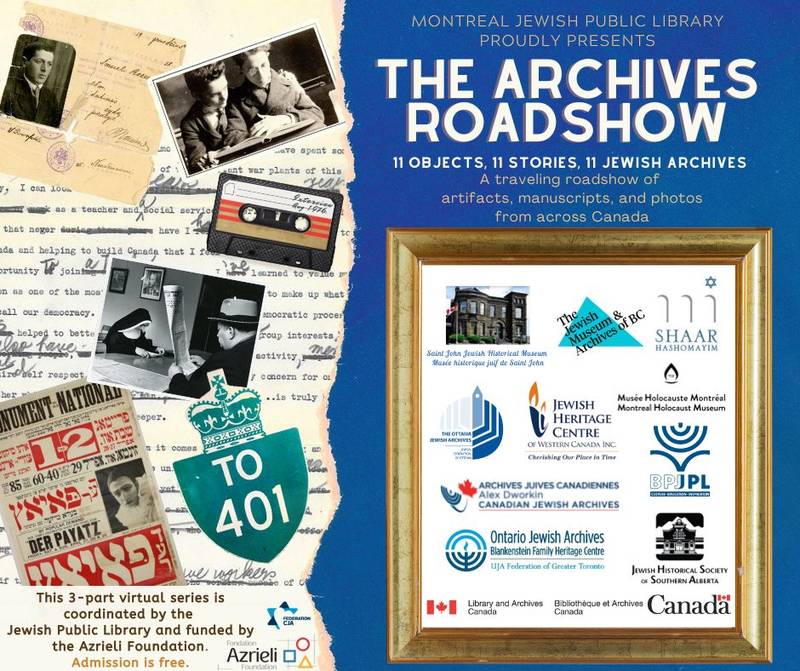
Memorial Display – From H.M.Victoria to H.M. Elizabeth:
| Author | |
| Date Added |
How the Shaar has memorialized and celebrated the British Monarch
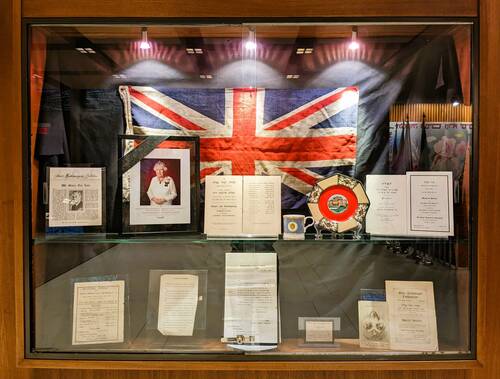
In early February of 1901, Congregation Shaar Hashomayim held a memorial service for Queen Victoria. This Saturday evening, as we mark one hundred years in our own building, we will be holding our fifth memorial service for a reigning sovereign: Her Majesty Queen Elizabeth II, who sat on the throne for most of that century. In a newly mounted display outside of the Chapel, we exhibit how our congregation has celebrated and memorialized momentous occasions for Canada’s monarchs, from Queen Victoria to Queen Elizabeth II.
Shaar Hashomayim was founded in 1846—just nine years into Queen Victoria’s reign. Since her passing in 1901, our Congregation has held memorial services upon the death of every Canadian Sovereign. Over the past year, we have shared how the Shaar has marked the coronation of Queen Elizabeth II (in honour of her Platinum Jubilee), the Diamond Jubilee of Queen Victoria (185 years since her ascension to the throne in 1837), and the death of King George VI (70 years this year). Yet we have far more materials documenting the Shaar’s respect for the Canadian Monarchy within the synagogue’s archives. In the display you will find materials relating to the reigns of Queen Victoria, King Edward VII, King George V, King George VI, and Queen Elizabeth II. (Of course, the only one missing is King Edward VIII, whose reign lasted under a year).
As you peruse the display you may notice that some of the pamphlets were printed and distributed by the Office of the Chief Rabbi of the British Empire (later United Kingdom and the Commonwealth), to whose leadership our own Congregation often looked, as we aligned ourselves with the British tradition. Another interesting paper to note is a letter from the office of the Governor General of Canada, thanking the Congregation for their official sympathies upon the death of King Edward VII in 1910.
We hope you enjoy the display and welcome your questions and comments!
Contact us at museum@theshaar.org or hsrourzackon@theshaar.org
50 Years Since Munich: The 1976 Memorial Service at the Shaar
BY HANNAH SROUR-ZACKON
| Author | |
| Date Added |
This past week, on September 5-6, we marked 50 years since the awful tragedy of the 1972 Munich Olympics massacre of 11 Israeli athletes. On July 12, 1976, less than a week before the Summer Olympics in Montreal, a memorial service was held at the Shaar. The memorial was a community-wide event, organized by Jewish leaders across the city.
The Montreal Gazette reported over 1,800 people in attendance, including massacre survivor Esther Roth, the widows and relatives of three of the murdered athletes, as well as 60 members of the 1976 Israeli Olympic team.
Also in attendance was Prime Minister Pierre Trudeau who read out Psalm 103 as part of the service, as well as Quebec Premier Robert Bourrassa, Montreal mayor Jean Drapeau, and International Olympic Committee chair Lord Killanin, among many others. This was the seating plan for the service:
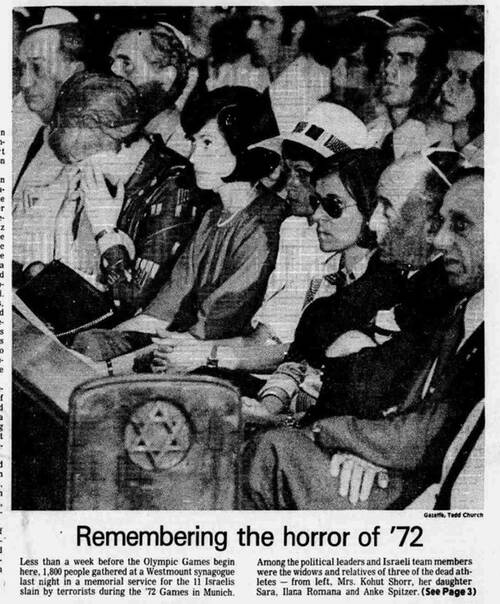
Security for the memorial service was heavy. The building was sniffed by three RCMP dogs for explosives before the Israeli athletes arrived. Moreover "a Canadian Armed Forces helicopter hovered overhead and combat-ready stood guard around the synagogue" among other measures.
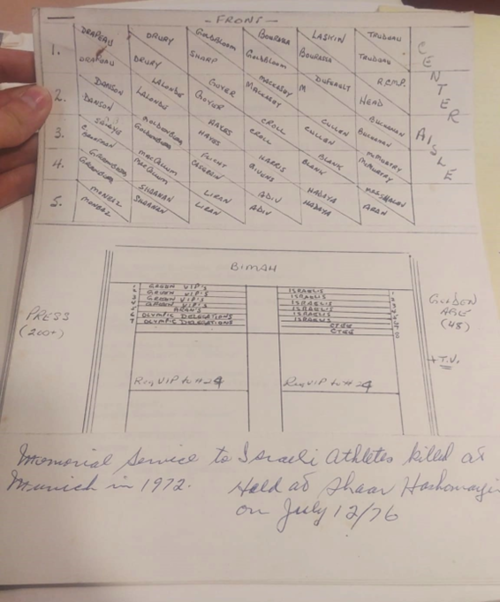
An important detail to note is the memorial was not held during the Montreal Olympics itself, being the first Summer Olympics after Munich. In fact, according to the Shaar’s September 1976 bulletin, the reason this memorial was organized in the first place was following “the refusal of the Olympics authority to include a two minute ‘silence of memorial’ at the opening ceremonies of the Montreal Olympics.” As we know, it would be many, many decades until the International Olympic Committee would memorialize the massacre during active Olympic events.
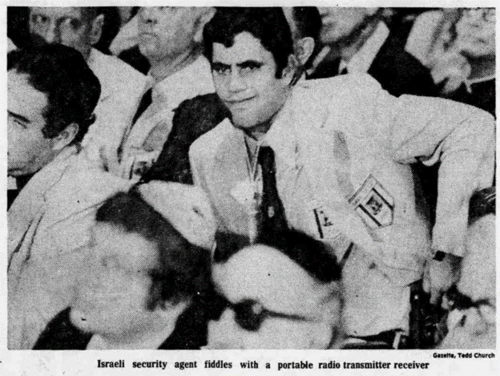
Read the Montreal Gazette article here
Sources:
- The Gate of Heaven: The Story of Congregation Shaar Hashomayim in Montreal, 1846–1896 by Rabbi Wilfred Shuchat
- July 13, 1976 (page 1 of 44). (1976, Jul 13). The Gazette (1867-2010).
- July 13, 1976 (page 3 of 44). (1976, Jul 13). The Gazette (1867-2010).
Got any questions? Contact me at hsrourzackon@theshaar.org or museum@theshaar.org
The Archivist Abroad: A Visit to Willesden Jewish Cemetery in London
BY HANNAH SROUR-ZACKON
| Author | |
| Date Added |
Willesden Jewish Cemetery
Willesden Jewish Cemetery is a Victorian-era cemetery founded in 1873 which has long been considered a prestigious place of burial. Many prominent Jews are buried there, including numerous Chief Rabbis of the British Empire, various members of the Rothschild family, many scholars and scientists, writers, poets, artists, and more.
Among the many people buried here are three past presidents of the Shaar Hashomayim, all members of the Moss family, who were among the earliest members of the congregation. As I am currently on a trip to London, I took a visit to the cemetery to visit their places of burial.
Archivist Hannah Srour-Zackon lays a stone on the grave of John E. Moss, Shaar president from 1885 to 1890
The Moss Family
When Congregation Shaar Hashomayim was founded in 1846 as a breakaway congregation from Shearith Israel (the Spanish and Portuguese), it consisted of only a handful of families. It took the congregation some time to find its footing. It was only when the prominent Moss family, who had established a successful business, joined the congregation that things began to move in more productive directions. The first generation of the family, brothers David, Edward, and Lawrence Moss, all born in England, were all integral members of the community. Both David and Edward were early presidents of the synagogue. It was David Moss who laid the cornerstone of the first building on St. Constant Street. Through Lawrence Moss died while still in Montreal, his two brothers both eventually returned to London where they remained for the rest of their lives.
Edward’s son John E. Moss and David’s son Hyam D. Moss (some records refer to him as Hyman) remained and became leaders of the congregation in their own right. John served as president of the congregation from 1885 to 1890 and Hyam as the congregation’s president in 1871 and 1881–4, as well as parnass. Yet eventually this second generation left for England too.
Why did the Moss family leave?
Rabbi Shuchat offers a plausible explanation for this in his book The Gate of Heaven: The Story of Congregation Shaar Hashomayim in Montreal, 1846–1896:
“This was a pattern followed by many families at the time… Why did they do so? For one thing, many of them regarded England as home and Canada as a temporary sojourn. If they were in a family business, they felt that they had spent enough time in the branch and wanted to return to the home office. Some families thought that their children would have better opportunities for marriage in England. There was also the question of being with family again and possibly being buried close to relatives. Presumably these considerations applied to the Moss family.” (p. 41–2)
Edward Moss
Edward Moss was born in London in 1816. He serviced as Shaar President in 1864, and died in 1876, just 11 years after leaving Canada. The front of his tombstone reads:
Sacred to the Memory Edward Moss Esq. of Inverness Terrace, Hyde Park, who departed this life December 8th 1876 5637, aged 62 years.
Deeply regretted by his sorrowing widow and children and a large circle of friends. May his soul rest in peace.
The side of the stone reads:
This monument was erected by his bereaved widow and children as a tribute of their love to the dear departed. He was a friend to all and his good deeds will follow him for many years. He was a resident of Montreal, Canada and his good works there remain to perpetuate his memory.
“A good name is better than precious ointment”
John E. Moss
Photograph of John E. Moss, date unknown.
John E. Moss was born in Montreal around 1843 and left for London in 1890 where he died in 1902. The years of his presidency were fruitful. It was under his leadership that the construction of the McGill College building was completed and the synagogue officially adopted the Shaar Hashomayim name. As Rabbi Shuchat writes in his book:
“At a meeting just prior to the consecration, John Moss, the president, offered this interpretation of the new name: ‘Only a year ago many of us thought it was only a dream and would never be carried out. But I am glad to be able to say to you to-day that if a dream it was, it was not unlike the vision of our Father Jacob who saw a ladder the summit which reached the Gate of Heaven. So we in our fond dream have been permitted to create the ladder of progress which will bring us up to the House of God which by the way will be designated, Shaar Hashomayim, the Gate of Heaven.’” (p. 40)
The tombstone of John Edward Moss reads:
In Loving Memory of John Edward Moss. Of 35 Winden Gardens W., late of Montreal, Canada, who departed this life May 25th 1902, 5662, aged 57 years. Deeply mourned by his sorrowing widow and children. May his Soul rest in Peace.
Hyam David Moss
Photograph of Hyam (Hyman) David Moss in the interior of the McGill College Synagogue. Hyam D. Moss was born in Montreal c. 1845 and served as the congregation’s treasurer and parnass, and later president in 1871 and 1881–4. P
The tombstone of Hyam David Moss reads:
In Loving Memory of our dear father Hyam David Moss, of 73 Queensborough Terrace W., formerly of Montreal Canada. Died October 21st 1914, aged 69. “Mark the innocent man and behold the upright, for the latter end of that man is peace.” [Psalm 37:37]
Sources:
1. https://www.willesdenjewishcemetery.org.uk/
2.The Gate of Heaven: The Story of Congregation Shaar Hashomayim in Montreal, 1846–1896 by Rabbi Wilfred Shuchat
Got any questions? Contact me at hsrourzackon@theshaar.org or museum@theshaar.org
Investigating the 1922 Cornerstone
BY CLAIRE BERGER AND HANNAH SROUR-ZACKON
| Author | |
| Date Added |
Following the unexpected dislodging of a time capsule from the 1967 cornerstone during construction on the Côte-Saint-Antoine plaza, we decided to act proactively and have the 1922 cornerstone of the building scanned.
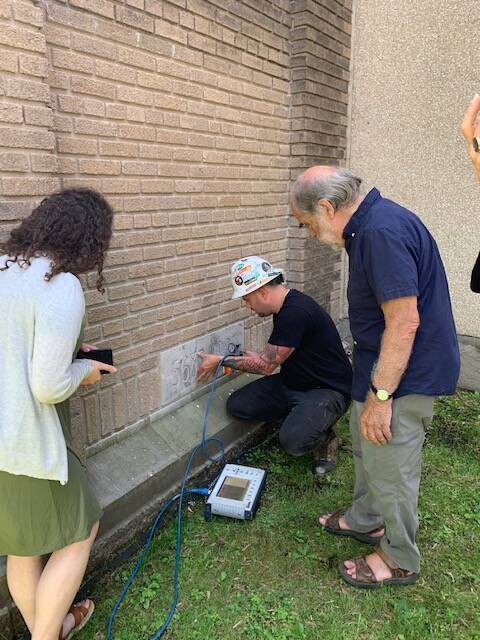 |
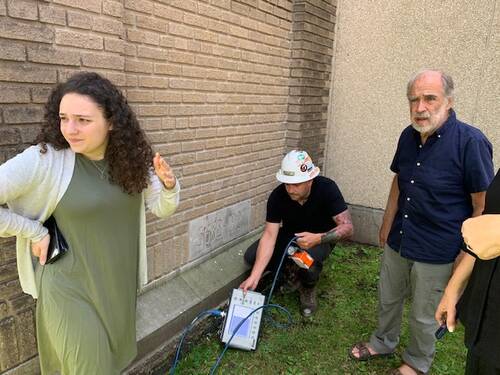 |
With the help of Radex who scanned the stone, we made the following exciting discovery: there is a metal tube centered in the 1922 cornerstone, indicating there is a more than 90% chance of something having been placed there. Given that it is a metal tube, the likelihood is quite high that this is yet another time capsule!
To gain a better read on the stone, the technician asked to scan the cornerstone from the building’s interior. Given the synagogue’s many renovations and expansions over the years, we pulled out the synagogue’s many architectural drawings and plans to investigate further.
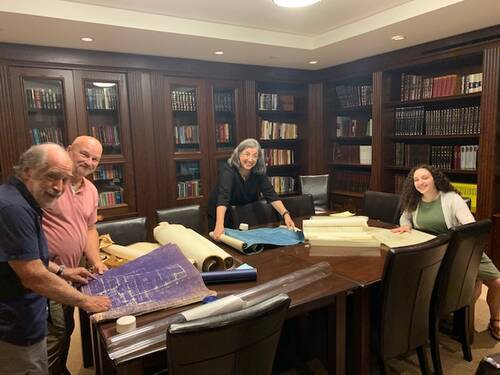 |
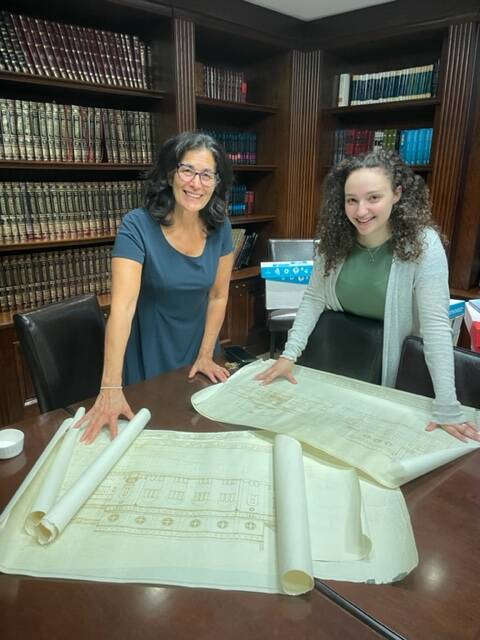 |
If there is indeed a time capsule, we will be taking additional steps to carefully remove and open the 1922 cornerstone so that the time capsule itself can be opened in time for our upcoming re-dedication of the sanctuary on September 17th of this year. Stay tuned as we continue our research…
The 1967 Time Capsule
BY CLAIRE BERGER AND HANNAH SROUR-ZACKON
| Author | |
| Date Added |
A few weeks ago, we wrote about a time capsule which was dislodged from the 1967 cornerstone of the building. This week, some 55 years later, we’re sharing in greater detail just what that time capsule contains.
Canada, Montreal, and the Shaar in 1967
1967 was a monumental year for Canada, Montreal, Jewish Canadians, Israel, and the Shaar. Canada was marking its centennial; Montreal was at the centre of the worlds’ stage as the host of Expo 67 (at which the Shaar’ Rabbi Shuchat created the Pavilion of Judaism); and Israel had just won the 6-day war.
Meanwhile, Montreal’s Jewish community and, as a result, the Shaar’s membership, was greatly expanding. It became evident that the Shaar would need to expand to accommodate the increase in congregants. The congregation launched a campaign entitled “Progress Through Expansion” to raise funds for the expansion and, on October 1, 1967, the cornerstone was laid.
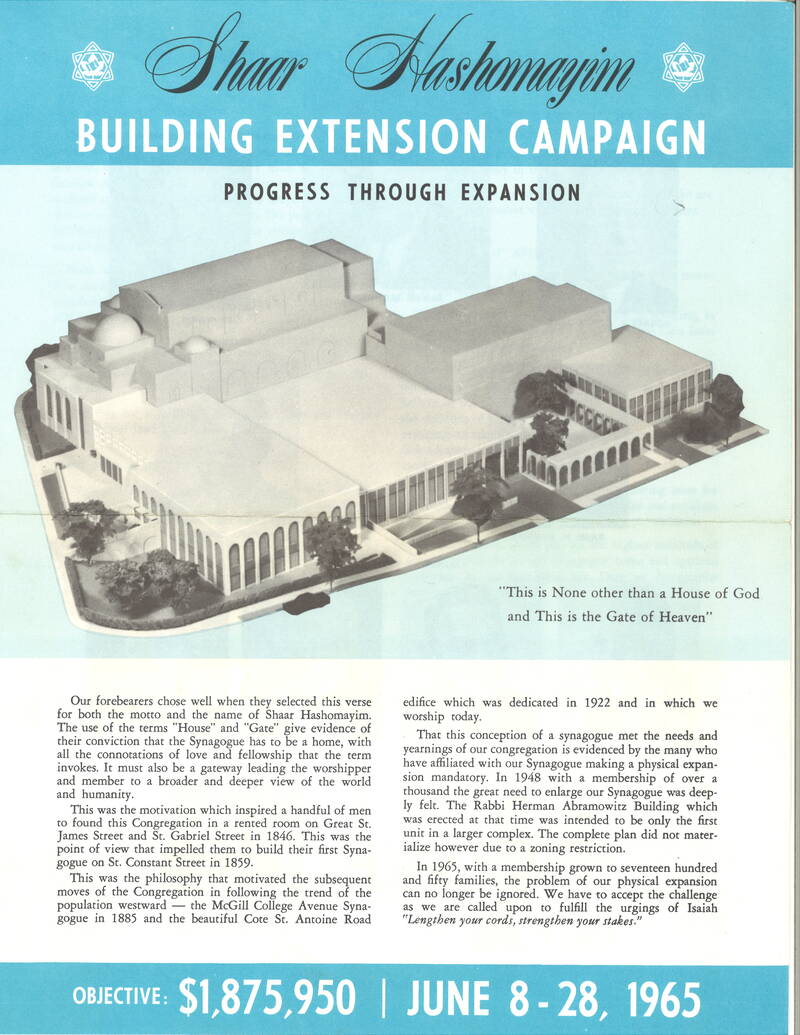
So what’s in the time capsule?
The time capsule contains a diverse array of documents. The first are materials that provide context about Canada in 1967 and Jews in 1967. This includes a few pamphlets and papers relating to Canada’s centennial and Expo 67, and a time magazine issue about the 6-day war.
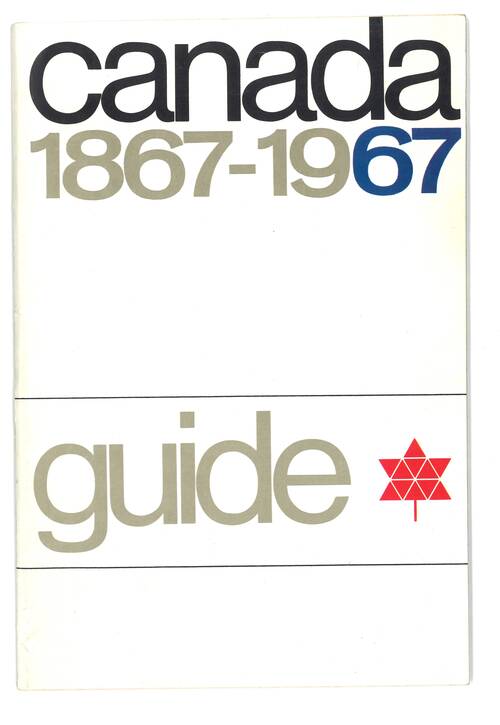 |
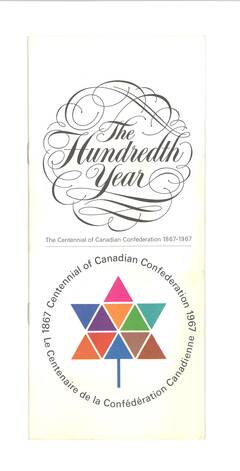 |
|||
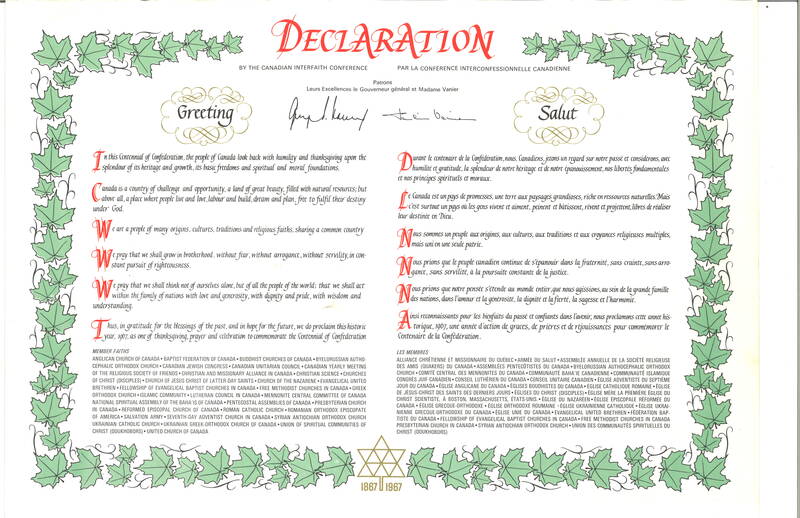 |
||||
Declaration by the Canadian Interfaith Conference.
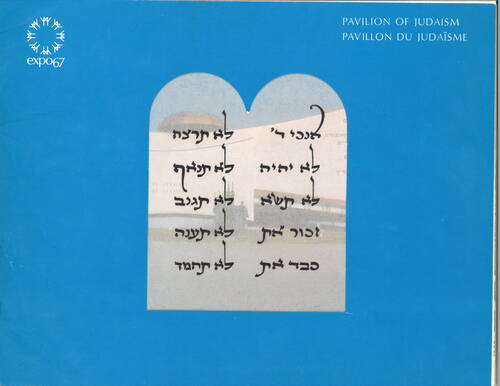
Souvenir booklet from Expo 67’s Pavilion of Judaism
The rest of the documents in the time capsule all relate to the Shaar. This includes the printed New Years Announcements from 1967, the program for the laying of the cornerstone, a photograph of the Shaar building prior to the expansion, and the text of the sermon delivered by Rabbi Shuchat on the occasion of the laying of the cornerstone, tantalizingly entitled “The To-Morrow of the Shaar,” in which he reflects on the history of the Shaar and the future of the Shaar moving forward as they expand.
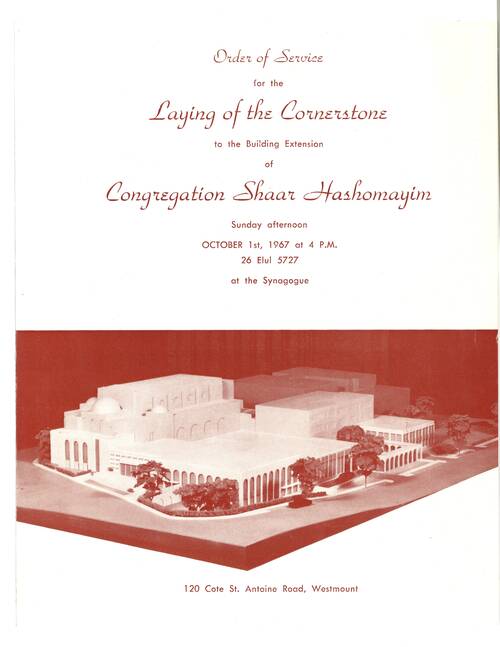 |
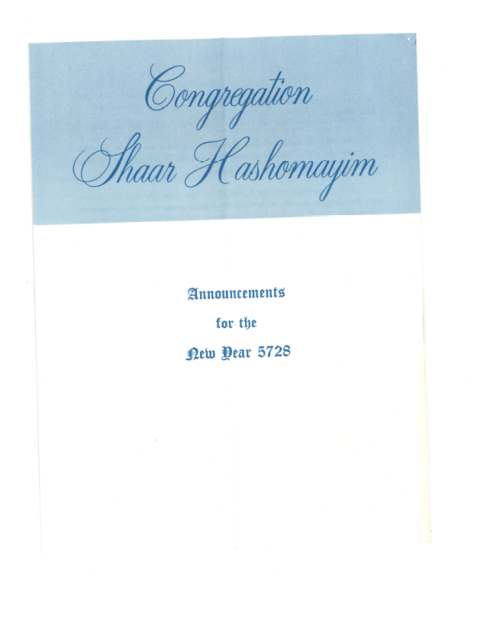 |
Most fascinating above all, however, are three letters from the Synagogue’s then-President Dr. Harry Ballon, the synagogue’s Parnass Jules Roos, and from Rabbi Shuchat. In Rabbi Shuchat’s letter he begins “To the Rabbi and President of Congregation Shaar Hashomayim many years hence-shalom!” He then details what to find in the time capsule and ends with the following reflection: “We are far from living in a world of peace. The Jewish People after the terrible destruction of the Nazi Period 1933-1945 are making spiritual and national progress everywhere except in Soviet Russia.”
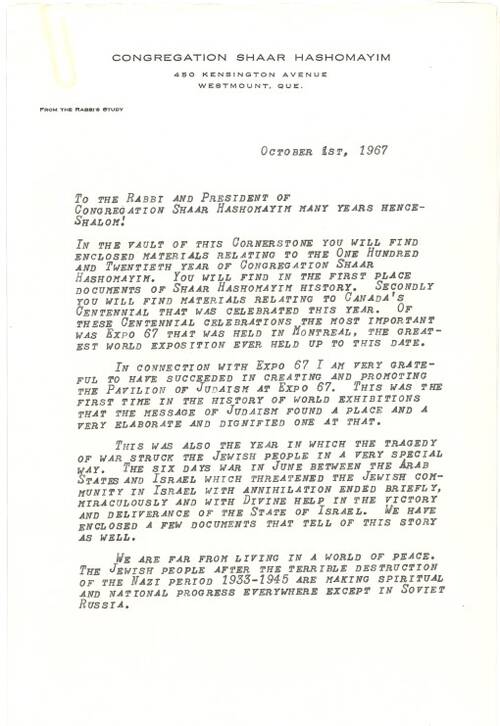
Queen Victoria’s Diamond Jubilee
BY HANNAH SROUR
| Author | |
| Date Added |
As we have written about several times over the past year, the Shaar Hashomayim holds deep ties to the English tradition, especially exemplified in its celebration and commemoration of reigning English monarchs. This past week on June 20th marked 185 years since Queen Victoria’s ascension to the throne in 1837. The Shaar marked the occasion by holding a special evening service of thanksgiving and praise in Her Majesty’s honour. Interestingly, this service was held during Lazarus Cohen’s first of many years as President of the synagogue.
The Rabbi serving the congregation at the time was Reverend Isidore Myers (1856-1922). It was Rabbi Myers who provided the English translations of the psalms sung for the occasion. He moreover composed lyrics to an original “Jubilee Anthem” in both English and Hebrew. This Jubilee Anthem was presumably sung to the tune of “God Save the Queen.” The opening lyrics are as follows:
God bless our Sovereign still,
Guard her from every ill,
Lord, we implore!
Rabbi Myers, however, was only with the congregation for one year (1896-1897) and would leave just months later to California. You can read more about Rabbi Myers here (note: the Shaar has a copy of the book mentioned in the linked blog post)
The Chazzan at the time, as noted on the pamphlet was Rev. Victor Rosenstein, who would stay with the Shaar until 1899. Rosenstein eventually moved to Los Angeles where he was the first chazzan hired by a Los Angeles Synagogue. You can read more about Chazzan Rosenstein here, on the website for the Jewish Museum of the American West (it appears he may have been a controversial character).
Another interesting detail appears at the bottom of pamphlet, noting the name of the printer.
A. L. Kaplansky, better known as Abraham Leon Kaplansky (1860-1939), established Canada’s first Hebrew and Yiddish printing press shortly after he immigrated to Montreal in 1893 (just four years before this special service). Kaplansky would go on to become one of the most prominent Jews in Canada.
Read the pamphlet from the Special Service in Honour of Queen Victoria’s Diamond Jubilee
Queen Elizabeth II’s Coronation
BY CLAIRE BERGER AND HANNAH SROUR
| Author | |
| Date Added |
This year countries across the commonwealth are celebrating Queen Elizabeth II’s Platinum Jubilee, marking 70 years since her ascension to the throne in 1952.
As a synagogue with deep ties to the English tradition, the Shaar has always taken pride as a congregation in the British Empire. During the war years, many of Rabbi Abramowitz’s sermons express gratitude to the British monarchy for the stability they have provided for Jewish communities across the Empire.
Previously we shared how the congregation marked the death of Queen Elizabeth’s father, King George VI. This week will mark 69 years since Her Majesty’s coronation which was held the following year on June 2nd, 1953. In honour of the occasion, the Shaar held a special service on the shabbat before the coronation on May 30th, 1953: “Prayer and Thanksgiving for the Coronation of Her Majesty Queen Elizabeth”.
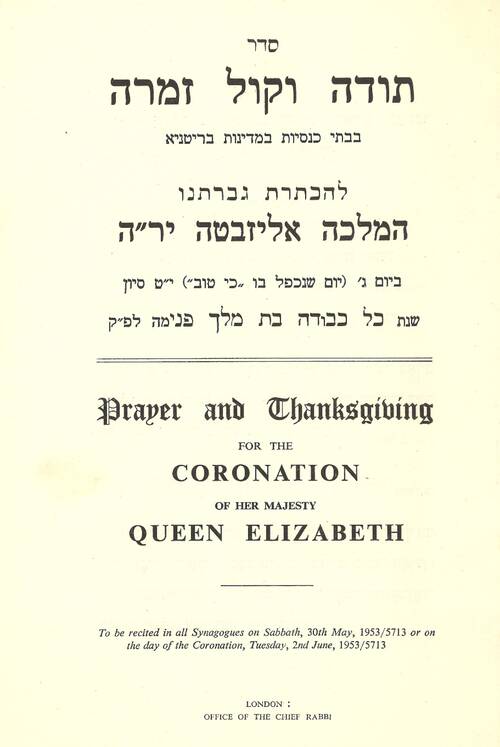
The service pamphlet was arranged, printed, and distributed by the Office of the Chief Rabbi of the British Empire. The special service consisted of psalms and prayers recited in honour of Her Majesty and concluded with a jubilant recitation of God Save the Queen (printed in both English and Hebrew).
Yom Haatzmaut: The Shaar and the JNF
BY CLAIRE BERGER AND HANNAH SROUR
| Author | |
| Date Added |
The Shaar has been active in the Zionist movement from the days of Theodor Herzl. Lazarus Cohen, a former president of synagogue, purchased land in Palestine as early as the 1890s, and Rabbi Abramovitch was a fixture at many of the first Zionist congresses. It is not surprising, then, that Shaar was involved with the Jewish National Fund (JNF) from its early days too. In our museum collection we have a few JNF certificates from those early years.
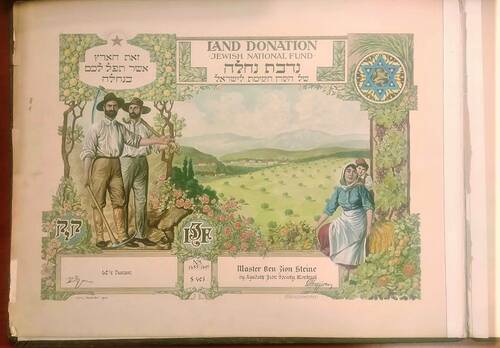
These certificates, which are bound in a large book together, show contributions made to the JNF Land Fund in the name of “Master Ben Zion Stein” on the occasion of his Bar Mitzvah on November 23, 1912 (Montreal, Quebec), totaling $425 (nearly $10,000 today) by the Agudath Zion Society of Montreal.
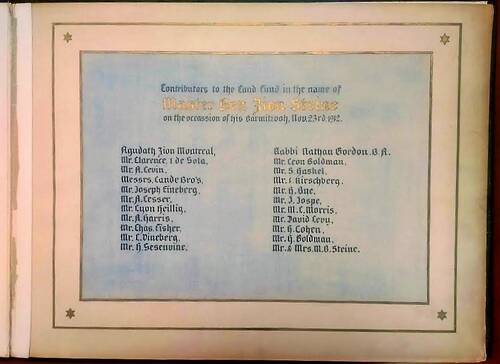
The next page shows all the names of the contributors, most of whom were leaders at the Shaar, as well as being major philanthropists in Montreal’s Jewish community.
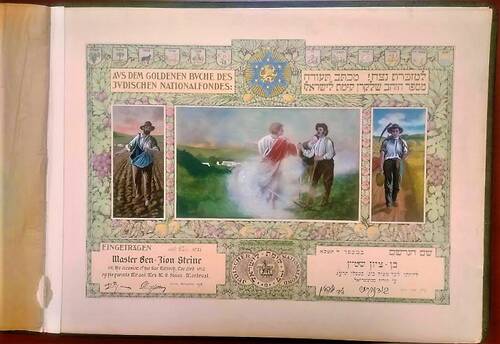
The final page notes that, in addition to the contributions made in Ben-Zion Steine’s name to the land fund, his name was also inscribed in the JNF’s golden book—a great honour which the JNF still offers today.
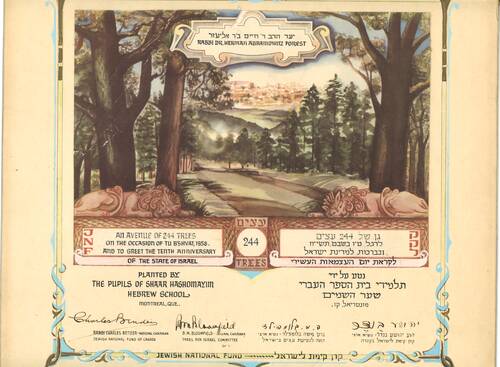
This certificate, from 1958, was in contribution to the Dr. Rabbi Herman Abramowitz Forest. 244 trees were planted by the pupils of the Shaar Hashomayim School on the occasion of the 10th anniversary of the State of Israel.
Early Commemoration of the Holocaust at the Shaar
BY CLAIRE BERGER AND HANNAH SROUR
| Author | |
| Date Added |
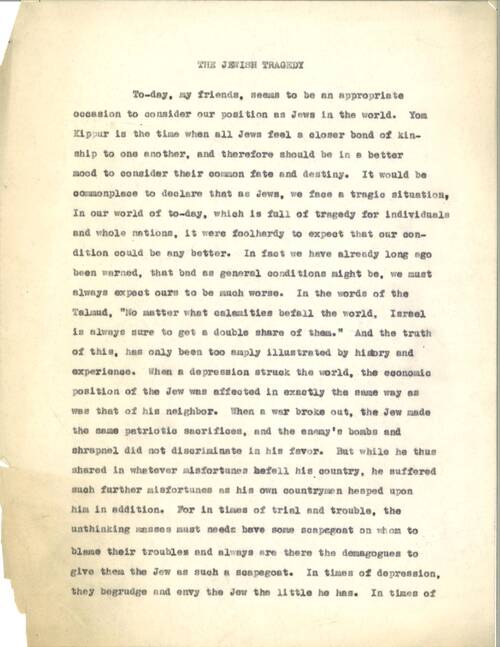
Earlier this week we marked Yom Hashoah in commemoration of the Holocaust. It is a common misconception that the world did not know of its horrors until after the fact, but Jewish communities worldwide were constantly sounding the alarm. Among the Shaar Hashomayim’s archives includes a number of sermons given by Rabbi Herman Abramowitz. Recently rediscovered among his papers is a chilling sermon delivered on Yom Kippur in 1941 entitled “The Jewish Tragedy,” in which he addresses the tragedies already wrought upon Europe’s Jews and those which were still ongoing. When speaking about Jews living in Nazi-occupied territories, he writes: “To-day they are no longer heard from; and are as if completely blotted out.” The sermon is powerful and moving, as Rabbi Abramowitz urges the Jewish community to “strengthen the spirit of Jewish loyalty everywhere, as an answer to the challenge of our enemies.”
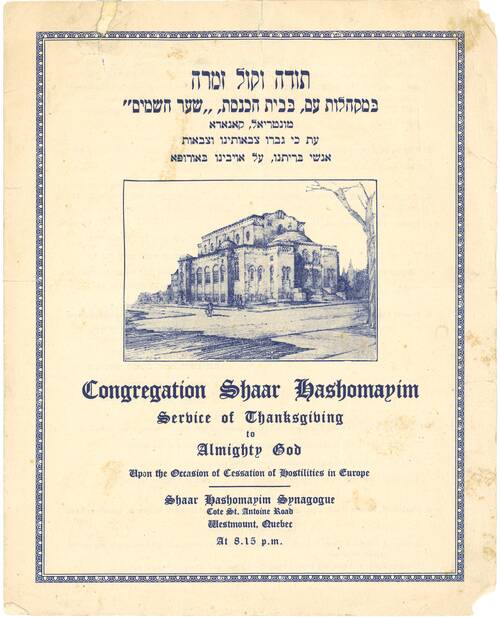
In the immediate aftermath of the war, “Holocaust” was one of many terms circulating in reference to the destruction of European Jewry. In those early post-war years, survivors were often referred to as the ‘surviving remnant.’ When the war was finally over, the Shaar held a special service of thanksgiving upon the end of the hostilities, part of the program included a “prayer for the remnant of Israel who survived the Nazi atrocities.”
Read “The Jewish Tragedy” by Rabbi Abramowitz here
Program for the Service of Thanksgiving Upon the Occasion of Cessation of Hostilities in Europe
A Model Seder from 1950
BY CLAIRE BERGER AND HANNAH SROUR
| Author | |
| Date Added |
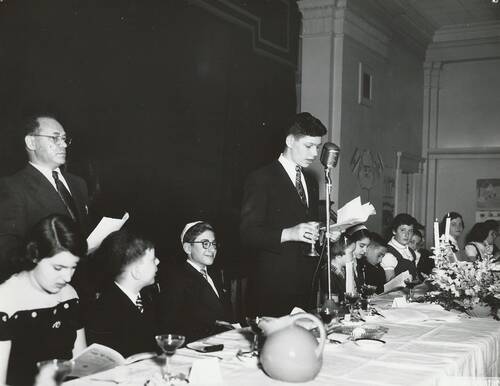
We recently found a wonderful photograph taken of a class seder at the Shaar’s Religious School in the spring of 1950 which has us reminiscing of model seders and Passovers past at the Shaar.
Here are some wonderful memories some of you have shared already:
“How I remember those years—[I] just loved the model Seders and practicing for them! We all knew the Seders by heart by the time they came around.” - Beverley Levitt Hamburg
“Each year as we choose our haggadot, we invariably come across the older copies with our model Seder “parts” complete with classmates’ names penciled in the margin and read with great confidence the role assigned to us all those years ago at the Shaar Afternoon school” - Anonymous
Thus far, we have identified the following people in the picture: Beverley Levitt Hamburg, Michael Cape (seated, wearing glasses), David Shapiro (the young man who is making kiddush), and Mr. Leibowitz (standing at the back).
Now, we want your help with identifying the rest! If you know anyone in the picture, or want to share your Shaar model seder and pesach memories, follow the form below:
Purim Wrap-up
BY CLAIRE BERGER AND HANNAH SROUR
| Author | |
| Date Added |
Though Purim has passed, we’re still going through our recently rediscovered treasure trove of Purim pictures! To wrap-up our Purim content for this year, featured this week is the cast photograph from the 1938 Purimspiel entitled “The Rise and Fall of the Hamantash.”
Click on photo to enlarge
Photograph donated by Marjorie Kirsch
The following was written about the Purimspiel in the March 25, 1938, edition of the Shaar’s bulletin:
SCHOOL CELEBRATES PURIM
Over 400 pupils and parents came together last Sunday morning for the Purim Celebration of our Religious School. The celebration took place in the Synagogue Auditorium.
The gathering was made welcome by Dr. H. Abramowitz, who spoke a few words of Purim greeting. It was announced that the total of Shalach Monos Baskets sent out by the School had been increased to thirty-three. The Women’s Auxiliary Society, and a small local social group were thanked for adding their contributions to the baskets.
“The Fall and Rise of the Hamantash”, a Purim Operetta in two acts, under the direction of Mr. S. Lerner, featured the celebration. The characters of the Book of Esther were portrayed by Horace Baittle, Meta Levin, Leslie Brodkin, Harold Finestone and Anita Elkin. The Hamantash was Peter Bronfman.
Others who participated were Sybil Freedman, Zipporah Batshaw, David Marshall, Judith Marshall, Billy Levy, Katherine Silver, Charles Bronfman, Edward Bronfman, Trevor Fineberg, Burril Fine, Donald Kirk, Allan Kirsch, Edgar Leibovich, David Robinson, Natalie Raginsky, Carmel Schwartz, Herbert Siblin, Lillian Brown, Florence Gersovitz, Beatrice Kirsch, Marguerite Kirsch, Naomi Pressman, Merle Rosenthal, Phyllis Sabbath, Vivian Zacks, Ronald Burg, Sidney Aronson, Barbara Flanders, Jerrold Fineberg, Eugene Gordon, Paul Gordon, Reva Leibovich, Edward Levinson, Shirley Levitt, Seymour Pressman, Renee Raginsky, Judith Rothbart, Eli Solomon, Fred Solomon, Alvin Shiller, Martin Taub, Arthur Victor.
The music was provided by Mrs. M. N. Fineberg. Victor Goldbloom was Stage Manager.
Special thanks are due to Mrs. Philip Levy, who assisted with the make-up and costuming; to the Hebrew Ladies Sewing Society, who kindly lent a hand in making the costumes; and also to Mr. T. Price and his assistant, Mr. Bert Lovering, for cheerful co-operation.
The celebration concluded with the Purim Treat distributed to the pupils of the School by our Women’s Auxiliary Society.
Shaar Youth Theatre
BY CLAIRE BERGER
| Author | |
| Date Added |
In 1973, the first group of Shaar Players performed To Live Another Summer, To Pass Another Winter which premiered on Broadway in 1971. It was a musical revue about all things Israel, ranging from the Bible to the establishment of the country. All of the early productions focused on Jewish themes and later included popular Broadway shows. Many of the young thespians went on to professional careers in the performing arts where they credit the Shaar Youth Theatre for sparking their love for all things performance and all will agree that fond memories and lasting friendships continue to this day. Not to be forgotten is the dedication of the parents who spent hours sewing costumes, carpooling, coordinating and fundraising to ensure a successful show each year.
“We had an amazing time on the set of Seven Brides for Seven Brothers. Great memory of going to Sheri’s Salon to have our long hair dyed bright red”
– David Sochaczevski with cast mates David Lipper, David Packer and Michael Shore.
“...... Most significantly, was the feeling of support and camaraderie from the entire cast. We all worked together. I had a pretty good sense of the role but, in some of the big musical numbers, I had no idea where to go or what to do and my cast mates just dragged me around the stage. Every once in a while, we improvised. Between scenes, I checked my lines and my notes. It was a feeling of community and collaboration unlike anything I had previously experienced.”
–Steven Chaikelson on filling in for sick cast mate on the very day of the performance.
READ THE FULL STORY
“I spent so may happy hours over 10 years enjoying the rehearsals while sewing the costumes for the teens, catching them for fittings as they waited for their scene”
– Ruth Berger Head seamstress
“....... I have so many amazing memories, mostly thanks to the incredible friendships I forged. Back then, there was nothing better than spending Tuesday and Thursday nights and all day on Sunday rehearsing, sometimes even extending the fun with a trip out afterward for a pot of tea at Café Santropol. ….... Beth, a professional costume designer, lent her skills to the Shaar Players every year and it was fabulous to watch her work, creating masterpieces out of scraps......”
– Janice Chaikelson, inspired by costume designer Beth Shore.
READ THE FULL STORY
“To think that we had plays that included a kitten (The House Behind) and yes in Milk and Honey, a sheep and a goat! That is a whole other story!”
- Allen Greenberg
Scroll through the images by clicking on the right side of the photo
The gallery includes photos from Ish Chassid Haya (1974), The House Behind (1975), The Grand Tour (1984), Once Upon a Mattress (1985), Seven Brides for Seven Brothers (1987), 42nd Street (1988), West Side Story (1989).
The Museum and Archives of the Shaar is hoping to complete this collection by asking all those who were involved in the productions from 1973-1995 to get in touch with us at museum@theshaar.org. Our aim is to collect and digitize films and photographs, conduct interviews, and compile all written memories. As we continue gathering information and items from our Shaar Players we hope to create an online exhibit for all to access.
Please be in touch!
Purim Part 2: Pictures from Purim-Past!
BY CLAIRE BERGER AND HANNAH SROUR
| Author | |
| Date Added |
Purimshpiels are plays or skits that are performed on Purim, and that typically playing satirize the Purim story. The history of purimshpiels goes back several centuries and is connected to the history of Yiddish theatre. Over the course of the 19th and 20th centuries, purimshpiels evolved, including into professional performances that would sometimes parody popular shows of the day. At the Shaar Hashomayim, purimshpiels and plays have been a mainstay of Purim celebrations over the course of its 175-year history! Ahead of Purim, enjoy some of the wonderful photographs from the archives which showcase some of those elaborate productions and pageants. If you recognize yourself or anyone in the photographs, please reach out to us at museum@theshaar.org!
How many Honorary Past Presidents can you find?
Scroll through the images by clicking on the right side of the photo
or click here to view the full gallery
Purim part 1: Megillot and Groggers
BY CLAIRE BERGER AND HANNAH SROUR
| Author | |
| Date Added |
Hava narishah - rash, rash, rash! Purim is less than two weeks away! This week we’re featuring some of the beautiful megillot and groggers from the Shaar’s museum collection.
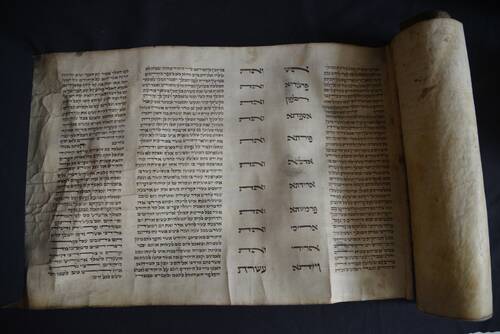
This remarkable megillah (c. 1830), written on parchment made of sheepskin, originates from Oran, Algeria, which had a large Jewish community. This was gifted to the Shaar by Gordon L. Echenberg.
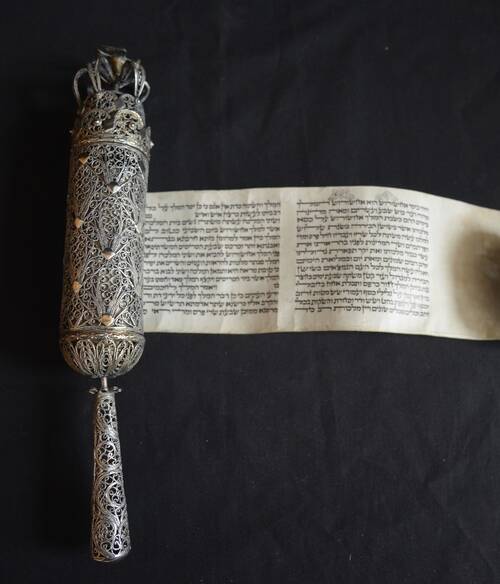
There are a few megillot in the collection which are encased in some beautiful silver cases. Pictured above is one of these megillot, made in Eastern Europe in the mid 19th-Century. Gifted to the Shaar by Mr. Harold Lande, 1991.
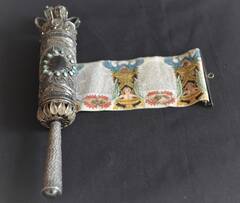 |
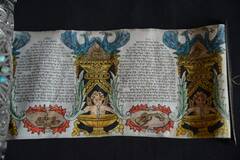 |
This megillah, with a silver filigree case, encrusted with turquoise and garnets, was made in the early 19th Century in the Middle East. Particularly impressive is the scroll itself, handwritten on parchment, and illustrated with blue peacocks, musical instruments, and mythical figures. The scroll was made around 1920 in Palestine. Gifted to the Shaar by Mrs. Max Y. Klein, Mrs. Gerald Weiner, and Mrs. Kenneth Shere in memory of their mother Edith Rosen, October 8, 1977.
Groggers
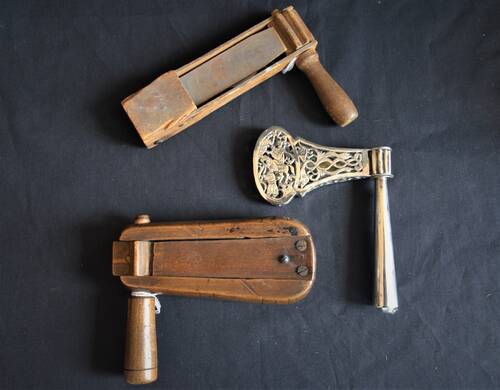
While many groggers we use these days are typically made of either metal or plastic, this was not always the case! In our collection, we have two wood groggers, and another made of silver. The grogger featured at the top of this photograph was made in Poland in the early 20th century. The other wood grogger (oak) at the bottom, was made in 1850. This one was gifted to the Shaar by the Guttman family in honour of Joseph Guttman’s birthday, 1985. It was initially purchased in Ripon, England at an antique fair. The silver grogger in the middle, made in the United States between 1920 and 1930, was a gift of Michael Lax in memory of his father, Dr. Sam Lax (April 14, 1980). This grogger is also quite ornately decorated.
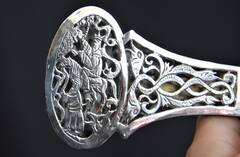 |
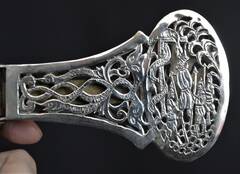 |
The grogger depicts two instances in megillat esther where Haman is humiliated or bested by the Jews whom he sought to eradicate. One side depicts the scene in which Haman is made to lead Mordechai on the king’s horse, declaring to all that this is what is done to one whom the king wants to honour. The other side depicts Haman hanging on the gallows.
Stained Glass Windows
BY HANNAH SROUR
| Author | |
| Date Added |
While the Shaar has many beautiful pieces of art dispalyed around the building, in many ways the building itself is a work of art. As you enter the Shaar Hashomayim at the main entrance to the building on Côte-Saint-Antoine, you will notice some beautiful stained glass windows. These were installed around 1968 around the same time as the building was expanded.
“The Burning Bush”
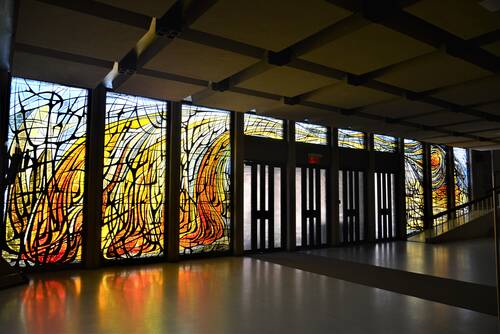
These stained-glass windows were designed by Lillian Hoffman and executed by technician Pierre Oesterrath who used chipped, slabbed glass, with epoxy cement joints. This technique was developed during the construction of the J. F. Kennedy International Airport Chapel, with Jordi Bonnet.
As the name of the piece suggests, these windows depict scene of the burning bush. The first three panels on the left depict the flames on the bush.
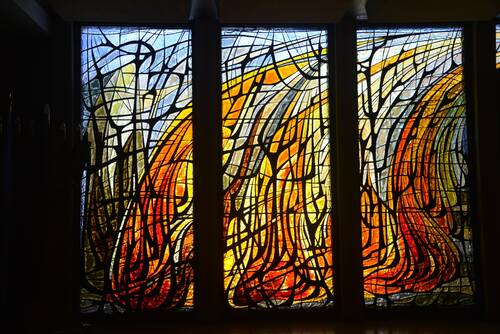
The three panels to the right show the embers of the flames floating off.
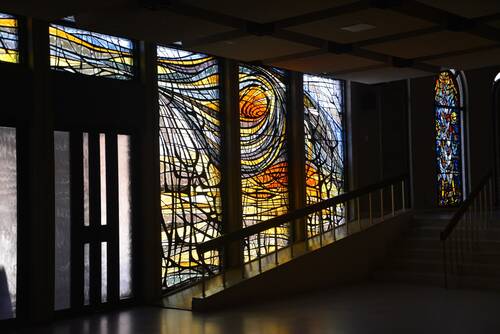
“Jacob’s Ladder”
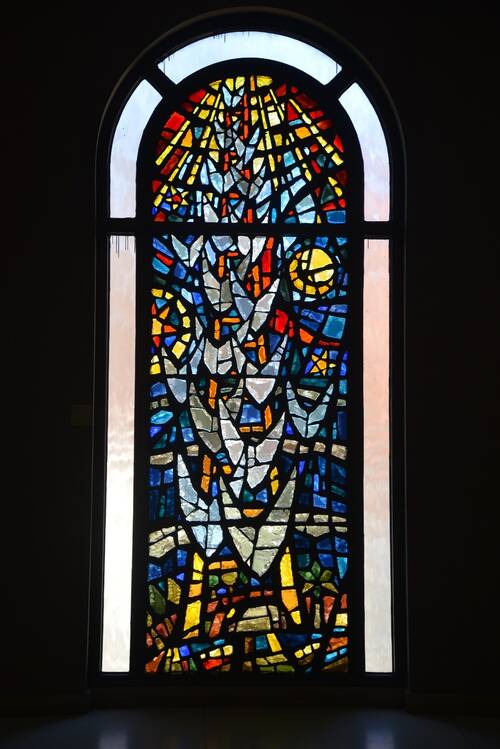
This stained-glass window (made of plate glass), which is opposite the entrance to the sanctuary, was made by Theo Lubbers and represents the ladder in Jacob’s dream after which he woke up and exclaimed:
וַיִּירָא וַיֹּאמַר מַה־נּוֹרָא הַמָּקוֹם הַזֶּה אֵין זֶה כִּי אִם־בֵּית אֱלֹהִים וְזֶה שַׁעַר הַשָּׁמָיִם
“Shaken, he said, “How awesome is this place! This is none other than the abode of G-d, and
that is the gateway to heaven.” (Bereishit 28:17)
The verse from which the Shaar derives its name.
“The Ten Commandments”
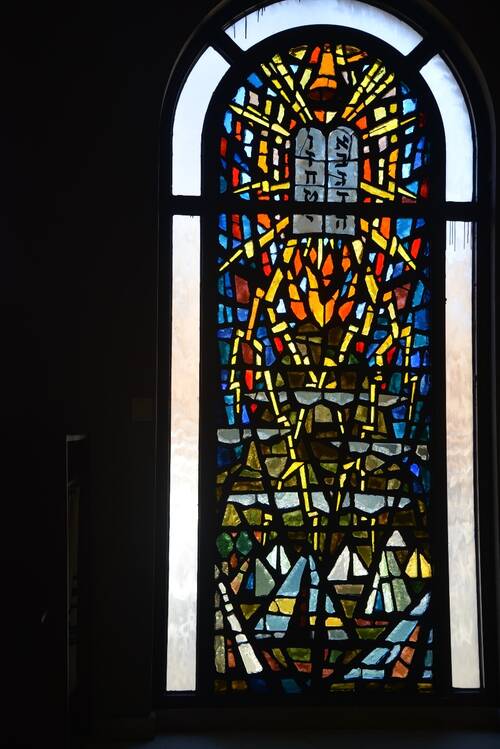
The other of the long windows across from the entrance to the sanctuary (also made of plate glass and designed by Theo Lubbers) represents the giving of the 10 commandments to the people of Israel.
Get to know our archivist!
BY HANNAH SROUR
| Author | |
| Date Added |
For the past few months, it has been our pleasure to share some fascinating items and papers in the Shaar’s archival and museum collection. This week we’re pulling back the curtain for a “behind-the-scenes” of the archive work and to answer your burning archive questions.
Get to know our archivist!
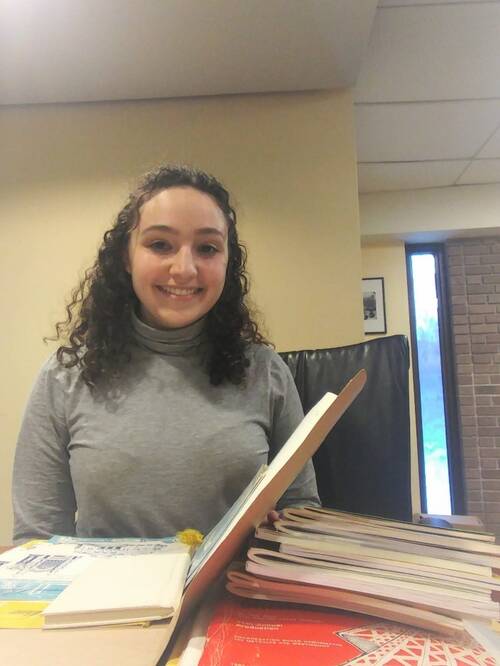
I’m Hannah Srour—the face behind many of the articles you have read. I am a born-and-raised Ottawa Jew, and I have my BA from McGill in Jewish Studies and English Literature, and a Master of Information with a focus in archives from the University of the Toronto. I am deeply passionate about Canadian Jewish history and Jewish community archives, and especially with connecting people with the wonderful histories of Canadian Jewry. When I’m not at the Shaar, I volunteer with the Association for Jewish Libraries in various capacities, including on their annual Jewish fiction award committee! Aside from sharing with you the fascinating history of the Shaar each week, I do a number of other things in the archives as well…
What is an archivist and what do they do?
An archivist works to collect, preserve, organize, and help provide access to primary material of enduring value (the specifics of ‘enduring value’ are up for debate and vary in different contexts). Items of any form can be of enduring value, including clothing! For the Shaar, material of ‘enduring value,’ means the synagogue’s historical papers and artifacts. A typical day for me is balanced between (1) organizing and taking inventory of our papers, (2) digitizing, and (3) promoting the collection.
What kind of items and papers do we have in the collection?
The collection includes correspondence, photographs, audio recordings, films, administrative documents, museum artifacts, bulletins, social programs, etc. A large portion of our archival collection consists of Rabbi Wilfred Shuchat’s papers which cover his many years and activities with the Shaar, beginning in the 1940s. We also have some papers of Rabbi Abramowitz, including some of his handwritten sermons. On the museum side, we have a beautiful collection of Judaica with items from all over the world, some of which are directly part of the Shaar’s history.
What items are you looking to collect right now?
We’re always interested in hearing about any materials related to the history of the Shaar! At this time, we are especially interested in the following things:
- Any photographs of Purim at the Shaar
- Photographs, programs, or film recordings of the Shaar Players youth productions
How do I get in touch to find out if my papers could form part of the collection, or if I have any questions about the archives and museum?
Please email us at museum@theshaar.org, and myself or Claire Berger will be happy to answer your questions!
“The King is Dead, Long Live the Queen!”: 70 Years since the Death of King George VI
BY HANNAH SROUR
| Author | |
| Date Added |
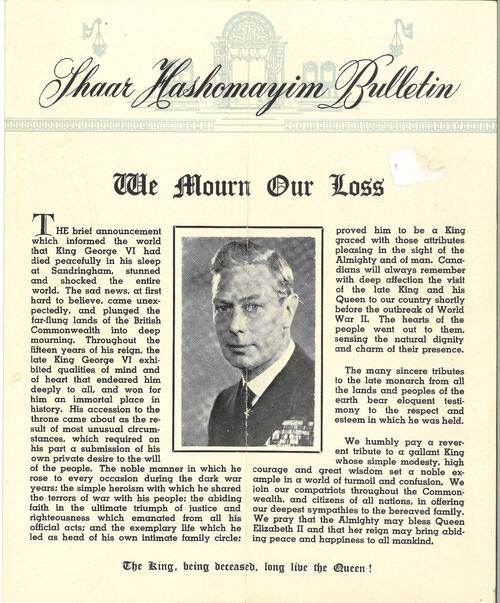
Earlier this week, on February 6th, marked 70 years since the death of King George VI—the father of Queen Elizabeth II. The King had been in poor health for some time and was especially ill from the Autumn of 1951. In fact, during that period, congregations across the British Empire, including the Shaar, took part in praying for the recovery of the king (a pamphlet was distributed by the office of the Chief Rabbi in London.)
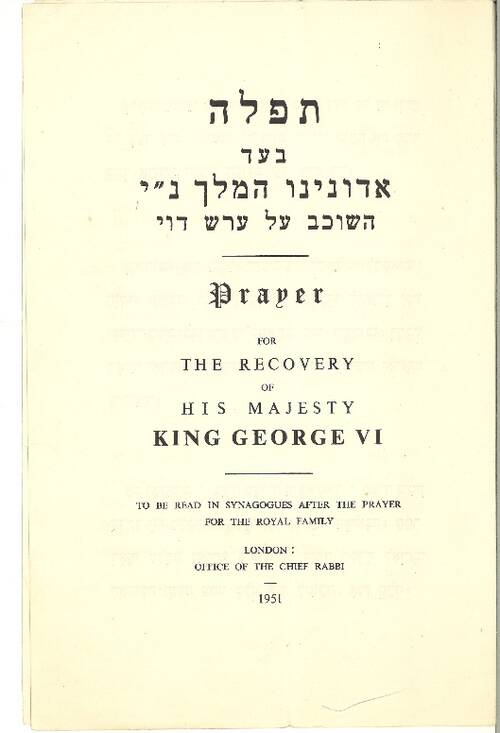
The Shaar’s bulletin from the week of February 15th shows just how the congregation responded to the death of the monarch, printing a dedication to the King on the front page. That week, Rabbi Shuchat’s sermon was entitled “The King is Dead, long Live the Queen!” marking the accession of Queen Elizabeth II to the throne (the same day her father died, on February 6th, 1952), whose platinum jubilee we celebrate this year.
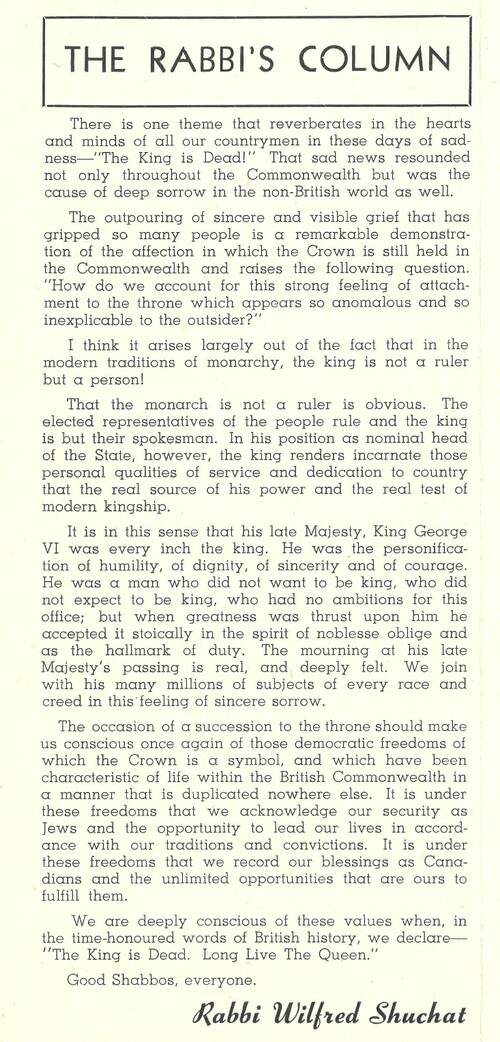
In his weekly column, Rabbi Shuchat wrote some reflections on the death and the legacy of King George VI, as well as on the positive experiences of Jewish communities in the British Commonwealth wherein they were living secure and free lives.
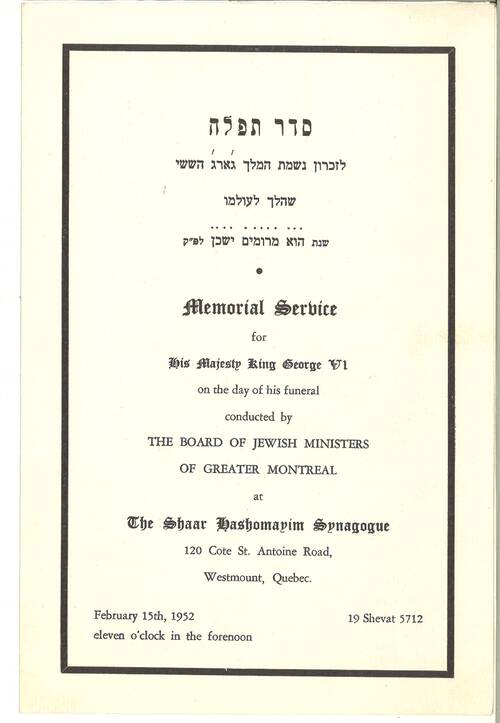
On February 15th, the Shaar organized and hosted a citywide memorial service to the King—the same day as his funeral—for Montreal’s Jewish community. In attendance were the board of Jewish ministers of Montreal as well as representatives from both local and national Jewish organizations, including the Brigadier Kirsch Branch of the Canadian Legion (for Jewish veterans). The service concluded with what would be among the first times of many that the congregation now instead sang “God Save the Queen.”
Shaar Bulletin, Week of February 15th (Death of King George VI)
Parashat Terumah and the Shaar’s Building
BY HANNAH SROUR
| Author | |
| Date Added |
What is the connection between Parashat Terumah and the Shaar’s Building? In this week’s parshah (Terumah) G-d provides the instructions for the construction of the Mishkan, the temporary and portable sanctuary that the Jews carried with them while wandering in the desert. Eventually the Jewish people would work to building a permanent sanctuary that became the Beit Hamikdash. Though perhaps less epic by comparison, the Shaar too has through the years carried out construction projects in the goal of establishing our own sanctuary. This week we will be featuring some photographs, documents, and drawings from some of those plans from across the years, beginning in 1885.
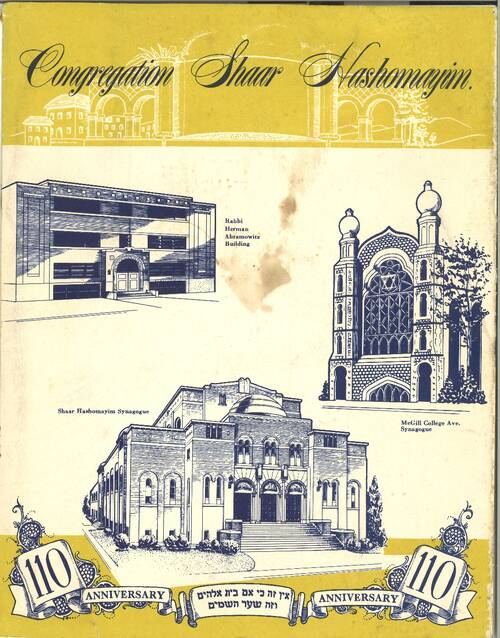
Program cover from the Shaar’s 110th anniversary in 1957, which includes drawings of old building on McGill College, the Sanctuary built in 1922 where we still are today, and the Rabbi Herman Abramowitz Building opened in 1948.
McGill College, 1885
This is the program cover from the laying of the corner stone for the McGill College synagogue building in 1885. Pictured also is the trowel that was presented to John E. Moss, then President of the congregation, who subsequently lay the cornerstone himself. At this time the Shaar was still being officially referred to as the “English, German & Polish Synagogue.” It was not until the dedication of the building a year later in 1886 that Rev. Elias Friedlander, then the rabbi of the congregation, declared the synagogue would hence be known as Congregation Shaar Hashomayim.
 |
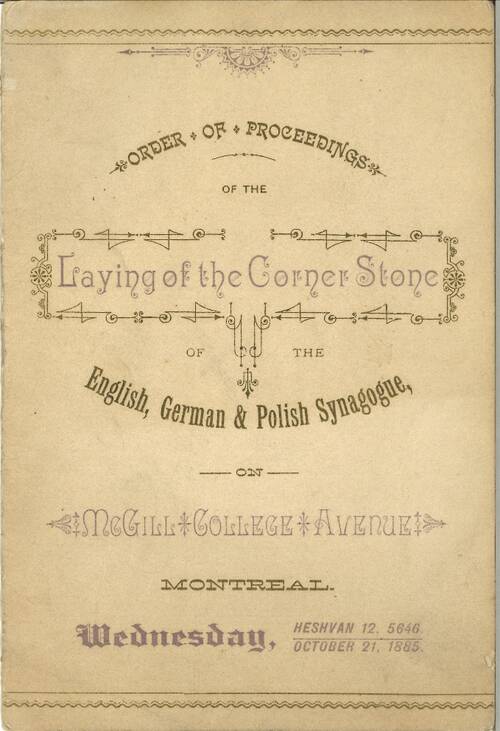 |
Cote St. Antoine and Kensington Avenue, 1922
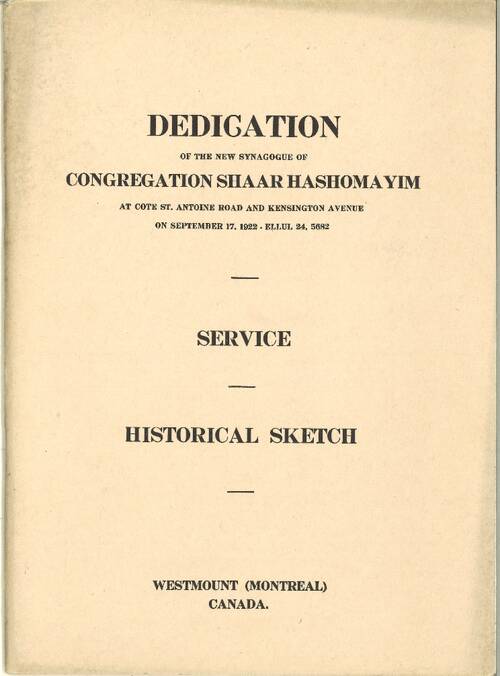 |
|
This program and invitation are from the dedication of the new synagogue building on Cote St. Antoine on September 17, 1922. On that day there was a procession from the old building on McGill College to carry the Torah scrolls to the new building. This was followed by beautiful dedication service which concluded with the singing of Hatikvah and God Save the King. If you had a good look at the year, you’ll have noticed that this year will mark 100 years in Westmount!
“Progress Through Expansion” Shaar Building Extension/Expansion
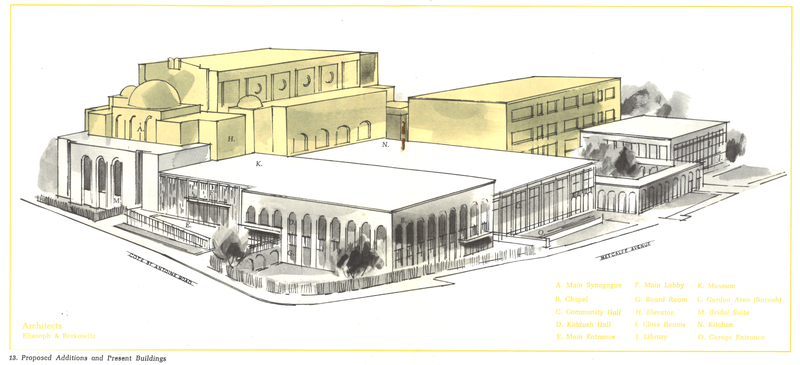
In this building the congregation has expanded and grown over the years. The Rabbi Herman Abramowitz building was erected in 1948 as an educational annex. In the 1960s the building was expanded once again to meet the demands of a growing congregation, during which whole new wings and rooms were added, including the new entrance lobby, the social halls, meeting rooms, kiddush rooms, and more. These images are renderings of what the proposed additions would like as part of the 1965 campaign to raise funds for the expansion project.
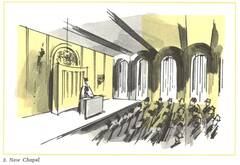 |
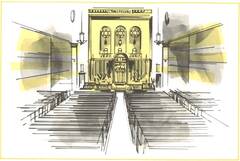 |
|
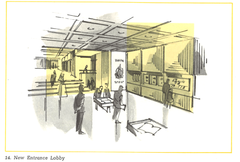 |
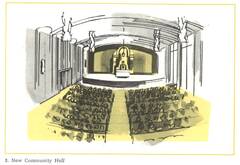 |
Link to “Order of Proceedings of the Laying of the Cornerstone of the English, German and Polish Synagogue”
Link to “Progress Through Expansion”
Havdalah Spice Boxes
BY HANNAH SROUR
| Author | |
| Date Added |
Though Shabbat in Montreal will continue to end early for the next while, nightfall is gradually getting later week by week, and so is the recitation of Havdalah. Among Shaar Hashomayim’s impressive museum items are a collection of silver besamim boxes (Havdalah spice boxes). These were mostly designed in the 19th century (like the two presented below), when besamim boxes in the form of towers were especially popular.
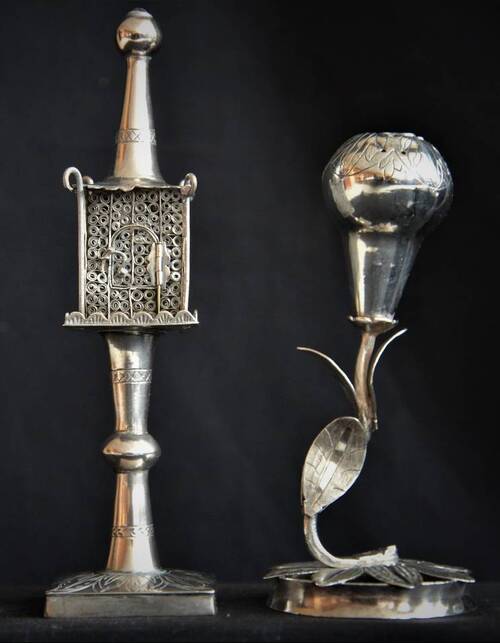
The spice box to the right, standing at approximately 13 cm in height, is in form of leaves on a vine, and originates from Russia. It was gifted to the Shaar by Ethel Gallaman, this was a family heirloom of her mother, Mrs. Joseph Gallaman.
The spice tower to the left originates from Italy. The centre of the tower, which holds the spices, is in the shape of a casket adorned with a pomegranate on the lid. The casket’s intricate filigree design is a mark of fine Italian craftmanship.
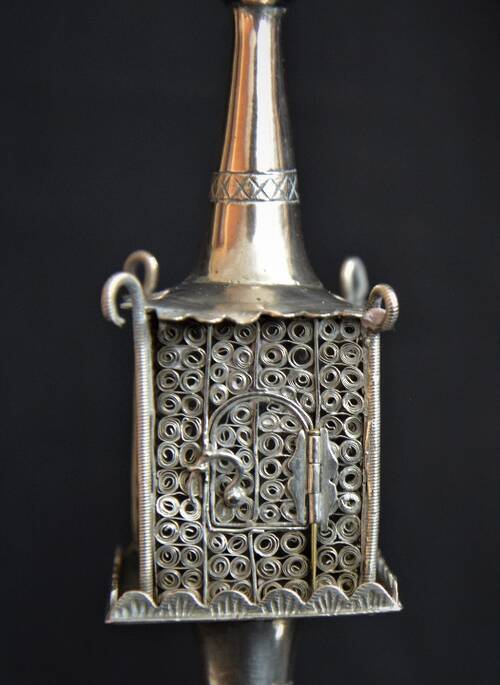
An up close view of the intricate filigree design.
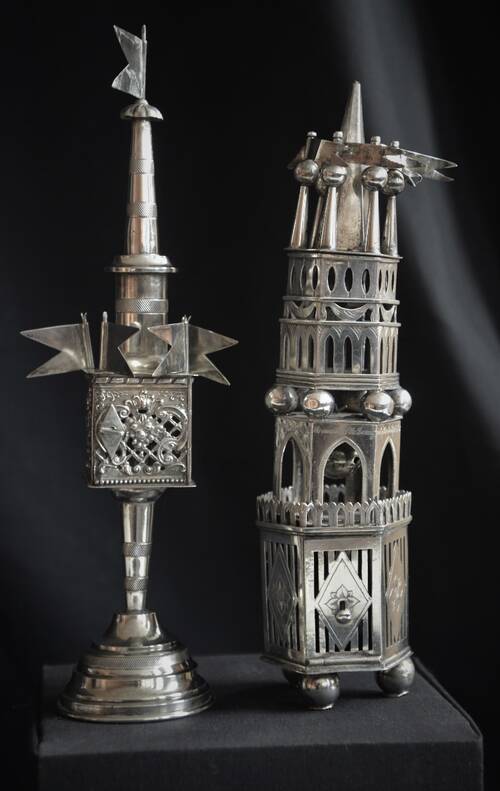
The spice tower to the left, though of unknown origin, was likely created circa 1800. Four flags surround the box, with an additional one on the top. When using this spice tower, however, one would best be very careful—those flags are quite sharp! This was gifted to the Shaar in 1979 by Mrs. Esther Goldenberg Heller, in memory of her husband, Dr. Benjamin P. Heller.
The besamim box to the right, also of unknown origin, interestingly places the box at the base rather than in the middle of the tower structure (you may be able to spot a tiny handle to open the slot). Six flags ornament the top of the tower (one flag is missing). This tower is also adorned with a number of small bells around the sides and one larger bell in the centre, all shaped like pomegranates, reminiscent of the rimonim that adorn Torah scrolls. One can imagine the sounds that this would make when being passed around during Havdalah! Inscribed around centre of the tower is the following: “Gift to Congregation Shaar Hashomayim by Mr. and Mrs. A. Fleming on the occasion of the Bar Mitzvah of their son, Stephan Cecil, May 17, 1952 (5712)”.
Books in the Shaar Museum
BY HANNAH SROUR
| Author | |
| Date Added |
The Shaar’s museum holds many fascinating Judaica items in its collection, including a number of books. This week we are featuring three beautiful books, all printed or composed around the late 18th and early 19th centuries, that are a part of our museum collections.
Siddur Safah Berurah
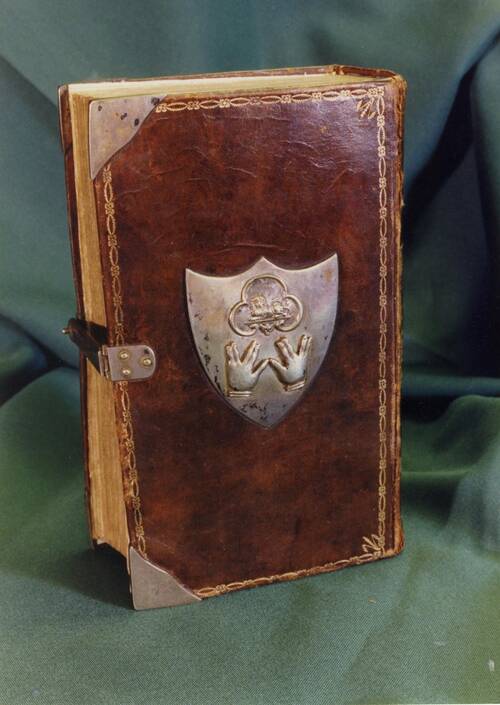
This gorgeous siddur, donated to the Shaar in 1988, was printed in Rödelheim in 1825 by the prolific German publisher, printer, and exegete Wolf Heidenheim (whose signature is printed on the title page). Heidenheim was born in 1757, and in 1799 established his printing house in Rödelheim, where it continued to operate for many years, including beyond his death in 1832. Besides this siddur, Wolf Heidenheim published numerous other editions of Jewish and Hebrew texts, including some with his own commentaries.
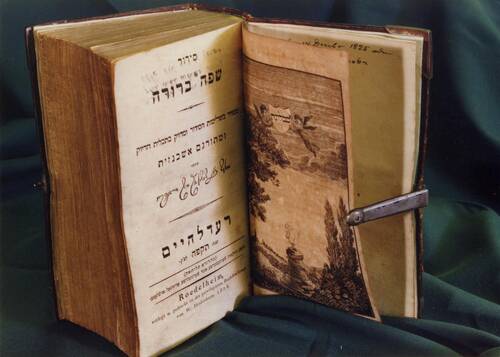
This edition seems to have been bound and engraved to be presented to a specific person: the front of the siddur features a silver medallion symbol of a family lion and the hands of the Kohanim, and the back has a silver medallion with the initials of the bride to whom this siddur was presented. The contents of the siddur itself are printed in Hebrew, Yiddish, and German and, as seen on the page adjacent to the title page, include some beautiful and detailed decorative engravings.
Handwritten Yemenite book of Haftorah / Haftorot
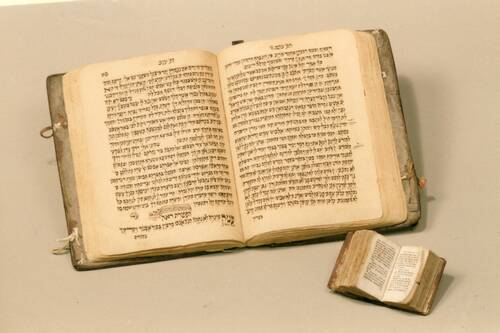
In this photograph are pictured two beautiful Hebrew books originating in Yemen. The larger of the two is a handwritten Yemenite book (Hebrew and Targum) of the Prophetic readings (Haftorah) composed in the early 19th century. Little else is unfortunately known about this beautiful manuscript book.
Siddur Kol-Bo
The smaller book is the Kol-Bo siddur (all inclusive, i.e., daily and holiday prayers all in one), composed circa 1750, which is bound in leather. This was gifted to the Shaar by Rabbi Charles Bender in honour of Mr. Allan Bronfman in 1968. The book is handwritten on vellum in Hebrew and Aramaic by a scribe whose name is not legible, though is inscribed in the book is, “the devoted, dedicated, and spirited Gabbay Tzedakah (Wardens of Charity) at Lisbon,” indicating the involvement of a person who collected and managed tzedakah funds.
Reflecting on Shabbat Shirah
BY HANNAH SROUR
| Author | |
| Date Added |
This Shabbat is Shabbat Shirah: the week we read Parashat B’shalach, which contains the Song of the Sea (Shirat HaYam; Az Yashir Moshe). Though it already has the designation of a ‘Special Shabbat,’ Shabbat Shirah at the Shaar is particularly significant. This year marks 70 years since the Congregation introduced its special Shabbat Shirah service. Beginning in 1952, the Synagogue’s Choir Committee set out to transform the service into an unforgettable liturgical concert experience—a Shaar tradition which has continued to this day. While current restrictions leave synagogues in Quebec temporarily shuttered, we can reflect nostalgically on Shabbatot Shirah of the past—in particular that of 1970.
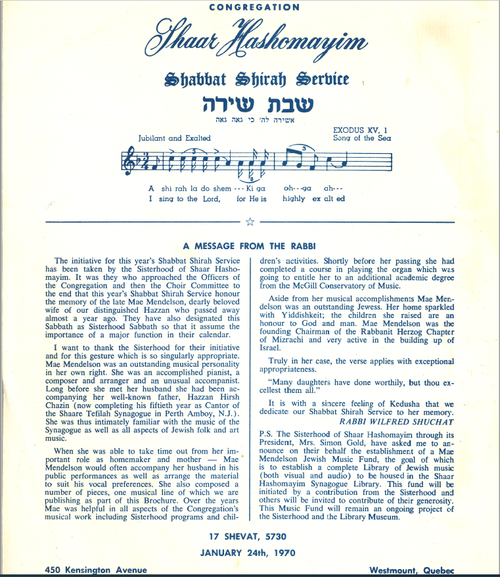
1970’s Shabbat Shirah service (full program linked below) was organized by the Sisterhood in honour of Hazzan Nathan Mendelson’s late wife Mae. The program records that many of the musical arrangements were composed by the Shaar’s choir director of over 30 years (1942–72), Prof. Jacob Rosemarin. In another section, the program remarks that a selection of other compositions may be chanted in the weeks to come, including an arrangement of Mi She’asa Nisim for Shabbat M’varchim. Picture below is Rosemarin’s handwritten manuscript arrangement!
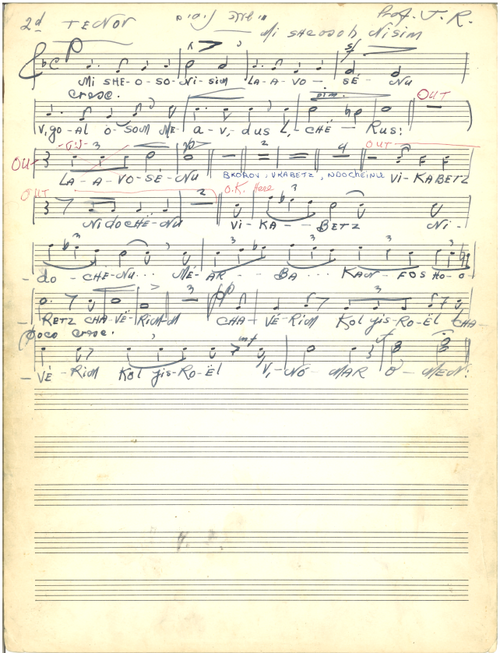
For a more immersive experience, listen below to selections from the record Hazzan Nathan Mendelson – Shabbat Morning Service (though not recorded on Shabbat!), some of which would have also been performed at the Shabbat Shirah service in 1970. (Please note, the music has been converted from a vinyl record and the sound quality reflects this.)
We hope you enjoyed this ‘sneak peek’ of the Shaar’s musical history. In the coming months, we at the archives will be going through some of the synagogue’s music and choir papers, and we look forward to sharing more of these fascinating pieces in the future.
Link to Shabbat Shirah Service Program 1970
Link to Jacob Rosemarin’s music manuscript for Mi She’asa Nisim
Link to “Hazzan Nathan Mendelson – Shabbat Morning Service”
A little bit of Déjà Vu
BY HANNAH SROUR
| Author | |
| Date Added |
Though things may be a bit more closed again these days, the Shaar’s archives are still open and at work. While January 2022 is looking a lot like January 2021, it is also looking a lot like September 1904! For our first item of 2022, we’re featuring an unusual (but incredibly familiar item) that was rediscovered some months ago in our collections – two cards certifying vaccination protection from around 1904 that allowed the card-carrier passage onto ships and any subsequent railroad travel in Canada.
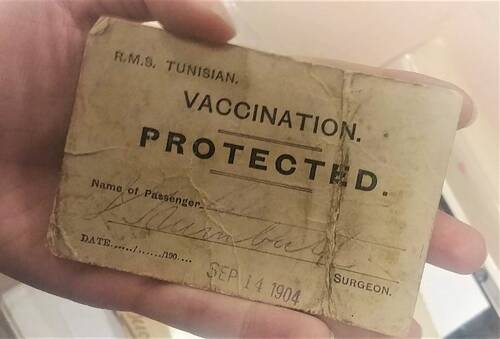 |
 |
 |
 |
The back of both read “Keep this card to avoid detention at quarantine and on railroads in Canada.” These may have been issued as a response to ongoing smallpox outbreaks in the United States. The signature of the certifying medical professional on both is visible. It is unclear at this time how the Shaar came to be in possession of these fascinating documents. Though from over 100 years ago, these vaccination passes are similar to our own vaccine passports today. Things that seem new and novel, such measures that encourage vaccination, may not be so novel after all!
As we start the new year, we at the archives want to know, what kind of items would you like to see and what kind of stories from the Shaar’s collections do you want to hear?
1924 President's Speech by Lyon Cohen
BY CLAIRE BERGER AND HANNAH SROUR
| Author | |
| Date Added |
Lyon Cohen (1868-1937) was a benevolent philanthropist, not just in the Montreal Jewish community, but across Canada and played an integral part in the establishment of many Jewish organizations. Cohen devoted his life to the Jewish community and served in many leadership roles, including as the first president of Canadian Jewish Congress and as a founder of the Jewish Immigrant Aid Society (JIAS) and co-founder of The Jewish Chronical among many others. Lyon Cohen was also a long-time President of the Shaar, serving two terms (1904-1907; 1914-1932) for a total of 21 years. The synagogue and the congregation grew immensely during those years, during which time Cohen oversaw the construction of the Shaar’s current building on Cote St Antoine.
“From an historical point of view, a period of one and a half years can be summarized in one sentence. In Lyon Cohen’s case, he admitted in one of his reports that he spent more time at the construction site than at his business. First thing in the morning, on the way to his office, he would visit the construction site, and if there was a crisis there, he might never get to the office that day.”
- The Gate of Heaven, Chapter 7. Rabbi Wilfred Shuchat
Chanukiyot of the Shaar - Part 2
BY HANNAH SROUR
| Author | |
| Date Added |
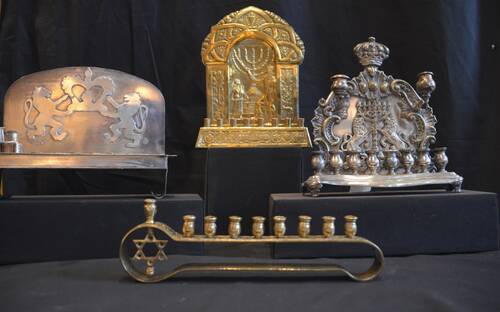
Continuing from last week, this week we’re featuring chanukiyot from around the world in the Shaar’s museum collection.
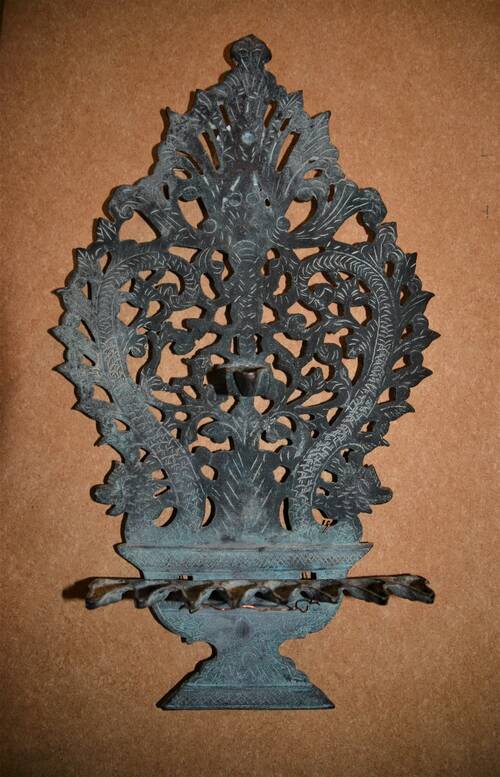
This bronze oil chanukiah from Morcco (c. 1860), though corroded over time, is still a remarkable piece. The back depicts the Tree of Life and the lions of Judah along with other motifs of Moroccan folk art. Unlike the chanukiyot we commonly use today, this chanukiah has a hook on the back and was meant to hang from the wall.
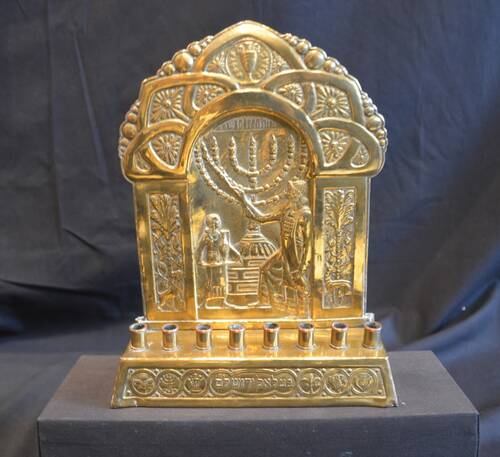
An early Bezalel chanukiah made in 1915. Written on the back is the following: “Made in Palestine at the art workshop of Sharar Betzalel, Jerusalem, P.O.B. 729.” The ornate design depicts biblical imagery of a lion and deer in front of palm trees. The centre shows the high priest (Kohen Ha-Gadol) lighting the menorah in the temple, assisted by a young boy carrying two jars of oil. At the top is written: “Ha-neirot hallalu kadosh hem.” Gift of Mrs. Esther G. Heller in memory of her parents, Adela and Maurice Goldenberg (parents of Senator Carl Goldenberg).
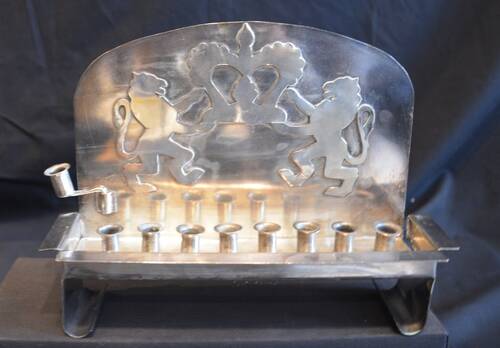
A silver and alloy handcrafted chanukiah made in Canada, between 1915-1925. The back shows two lions holding a crown.
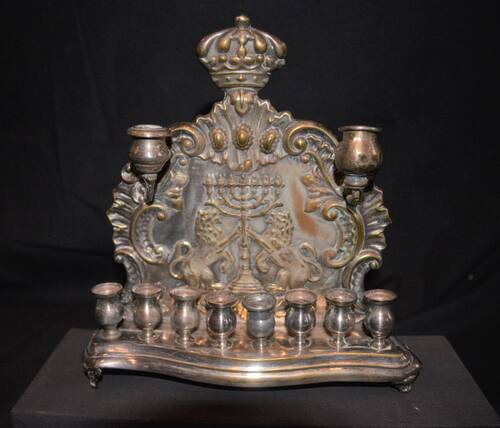
This absolutely stunning chanukiah from Poland (c. 19th C) is made of German silver. The back plate is made of brass and depicts two lions around a menorah. This chanukiah interestingly has two shamushim. The company that made this chanukiah was a Warsaw-based silver foundry called the “Brothers Henneberg” which was founded in the mid-19th century. Gift from wedding of Mrs. Jeanne (Lazare) Rosemarin. Donated to the Shaar in January 1987.
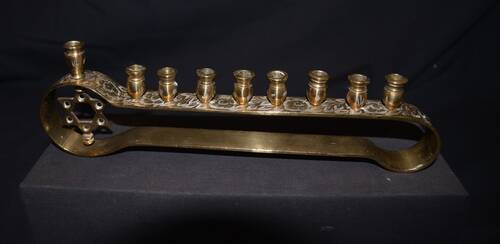
A chanukiah from East India (19th C.) Brass engraved, crude pattern on surface. Gift of Mrs. Morris Gelber, 1986
Chanukiyot of the Shaar - Part 1
BY HANNAH SROUR
| Author | |
| Date Added |
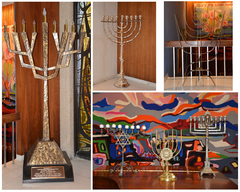
The Shaar has remarkable chanukiyot that are displayed around the synagogue and are in its collections. In the next two weeks we will be featuring a selection of some of those beautiful chanukiyot.
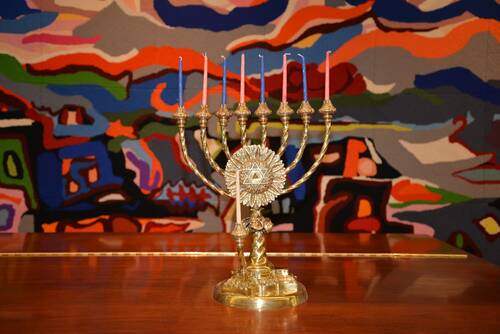
This chanukiah was made by the brass foundry W.R. Cuthbert and Co, of which Lyon Cohen became president in 1895. It is probably the oldest Canadian-made chanukiah. Inscribed at the base is the following message: “Presented to Shaar Hashomayim Congregation by Lyon Cohen, President, on the occasion of the Bar Mitzvah of his eldest son, Chanukah 5665 – December 3, 1904.” Lyon Cohen’s eldest son was Nathan B. Cohen, the father of Leonard Cohen.
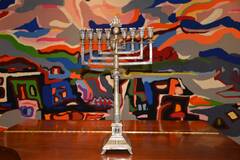
This ornate, silver chanukiah was presented initially as a gift in 1950 to Mrs. Jeanne (Lazare) Rosemarin on the occasion of her wedding and was later donated to the Shaar in January 1987.
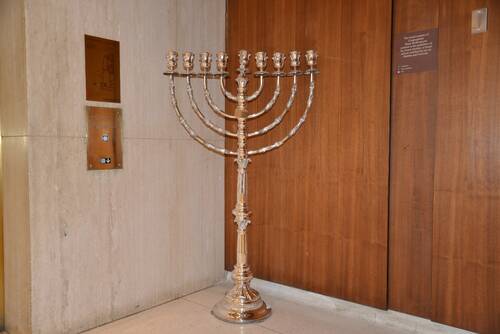
Presented to Congregation Shaar Hashomayim in honour of the Bat Mitzvah of Caroline Hoppenheim, April 5, 2003 / 3 Adar II, 5763, by Rosemary & Mel Hoppenheim & Family.”
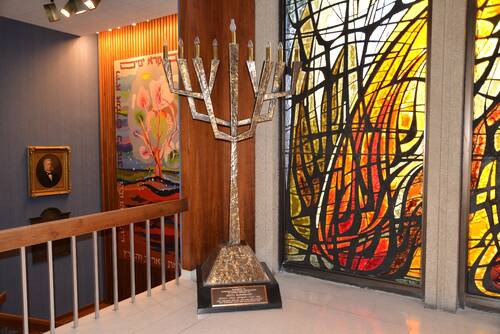
Presented to Congregation Shaar Hashomayim in loving memory of Betty Rudnikoff
Commemorating Kristallnacht: The Story of the last Chief Rabbi of Danzig
BY HANNAH SROUR
| Author | |
| Date Added |
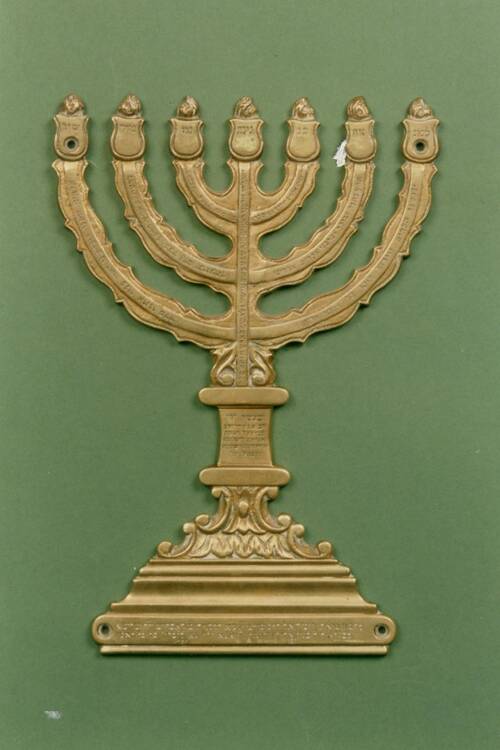
Behind every item is a wealth of stories. As we commemorate the 83rd anniversary of Kristallnacht on November 9–10, and as part of ongoing commemorations for Holocaust Education Month in Canada, this week we’re telling the story of one such object in Shaar Hashomayim’s collection. It is an account of a beautiful menorah emblem and of the man who gifted it to the Shaar: Rabbi Dr. David Weiss (1876–1966), the last Chief Rabbi of Danzig, who escaped to Montreal shortly before the Nazis occupied Danzig in 1939. The menorah is reminder of the persecution Jews faced in the wake of Nazi terror, of the lost Jewish community of Danzig, and of a bond between it and our own community in Montreal.
This emblem, made of brass, was once displayed upon the rabbinical chair at the Danzig synagogue which Rabbi Weiss served. On the branches, Tehillim 67:2 is inscribed: “May God be gracious to us and bless us; may He cause His face to shine to us, Selah.” Along the stem is written: “Hand-crafted by the young man Avigdor and the young man Tzvi, for the sake of the soul of their upright father, Yehuda Leib ben Akiva Cleiman, of blessed memory.” And the following is written at the base: “A gift from Israel Lifshitz, 1883, for the sake of the Rebbetzin Mrs. Robris (1850) and Joseph Chaim, may he live a long life.”
Rabbi David Weiss

Photo courtesy of the Montreal Gazette (January, 21, 1966, p. 23)
Rabbi Dr. David Weiss was born in Galicia in 1875 or 1876, and studied at the Universities of Berlin and Bern. In 1920 he took up his first rabbinical post in Danzig. At the time, Danzig had the special status as a Free City following World War I. As a result, the city saw a mass influx of Jews from Eastern Europe seeking refuge. This greatly increased the Jewish population and intensified the need for more religious and rabbinic services. Prior to the War, under 3,000 Jews lived in Danzig; by 1923 there were over 7,000, reaching a peak of around 12,000 by 1937. As the strain of supporting this largely refugee Jewish community became too big for then-Chief Rabbi Dr. Robert Kaelter, Rabbi Weiss assumed much of the burden of his work. During his next years in Danzig, Rabbi Weiss operated primarily at the Orthodox New Synagogue in Langfuhr.

Clockwise from Right: (1) The Choir of the New Synagogue in Langfuhr, Danzig, 1928, photo ID 121591, courtesy of The Oster Visual Documentation Center, Beit Hatfutsot, courtesy of Abraham Sherman. (2) The rear exterior of the New Synagogue. (3) The front of the New Synagogue, courtesy of JewishGen
While the horrific pogrom of Kristallnacht largely took place on the 9th and 10th of November, 1938, Danzig was beset with anti-Jewish riots from the 12th to the 14th, during which four synagogues in the city were near-totally destroyed, including Rabbi Weiss’s New Synagogue (the building was later restored and as of 2007 has primarily operated as a music school, with some use by the Jewish community). The Jewish community of Danzig quickly organized itself and emigrated en masse. Many of the community’s Judaica and other memorabilia were rescued and brought to the Jewish Theological Seminary in New York in the summer of 1939. By the end of the year, merely 1,600 Jews remained. Rabbi Weiss was one of the last Jews to escape the city before the Nazi invasion; he delivered his final sermon to his congregation on May 25th, 1939 (the text of which is below). As he left, he saved one item from the synagogue: the emblem of a menorah which adorned the rabbi’s chair.
Rabbi Weiss in Montreal
Rabbi David Weiss arrived in Montreal in 1939, via St. Albans, Vermont. While he never took another pulpit position, he continued his humanitarian and aid work until his retirement at age 85, working as a hospital chaplain for the Baron de Hirsch Institute and as part of the Jewish Chaplains’ Service of the Montreal Federation of Jewish Community Services. Though he learned little English or French in his time here, he faithfully served the European Jewish immigrant community, many of whom still could not speak the local languages.
He passed away on January 18th, 1966. His obituary, which ran the following month in the Canadian Jewish Review, reads:
“Rabbi Weiss had always had an interest in all those requiring solace, encouragement, and help, whether they were orphans, hospital patients, or prisoners. At the age of sixty-five years, when others think of retiring, he embarked on a new voluntary career of visiting systematically the Montreal hospitals providing a service not existing at that time. In fair and foul weather, Dr. Weiss would travel throughout the city and went as far as the Military Hospital in Ste. Anne de Bellevue to visit the sick.”
Rabbi Weiss is buried next to his wife Hortense, who predeceased him on March 23rd, 1960, in the Shaar Hashomayim Cemetery on Mount Royal.
READ RABBI DAVID WEISS' SERMON
Other Sources
Honouring our Congregants who fought for King & Country 1914-1918 & 1939-1945
BY CLAIRE BERGER AND HANNAH SROUR
| Author | |
| Date Added |
Major Moses O. Kirsch
Moses O. Kirsch had a sense of adventure and yearned to travel, and because he was too young, he lied about his age to join the infantry. Moe Kirsch fought overseas in World War I with the 10th field battery RCA as a signaler which usually meant you were close to the frontline troops, providing signals communications back to your Company and Battalion H.Q. Wired telephones were used where possible but this involved laying landlines which was a hazardous job due to enemy shelling. He would often joke that he had survived the war due to being so short that the bullets missed him. At the outbreak of World War II, Moses O. Kirsch re-enlisted and took an officer's course to become an instructor at Petawawa Ont. as he was too old to be deployed overseas. He retired from the army as a Major. All those who knew Major Kirsch and the soldiers in his battery always spoke very highly of him. He was a true gentleman, intelligent with a wonderful sense of humour. His great involvement at the Shaar included leading the Scout Troop for many years joined by his wife Ruth Salomon Kirsch who was the Girl Guide Captain.
In the photos below, he can be seen with his nephews Sidney, Lionel and Arthur Kirsch who also bravely fought in the Canadian Armed Forces in WWII
Below: The 10th Canadian Medium Battery CA before deployment overseas.
Moses Kirsch with comrades in WWI with host family in France. Moses Kirsch’s Soldiers prayer Book 1916, Major Moses Kirsch with nephew Lionel Kirsch whose plane was shot down over Europe.
Stories and photos provided by his granddaughter Marjorie Kirsch Heft.
Colonel Bernard J. Finestone
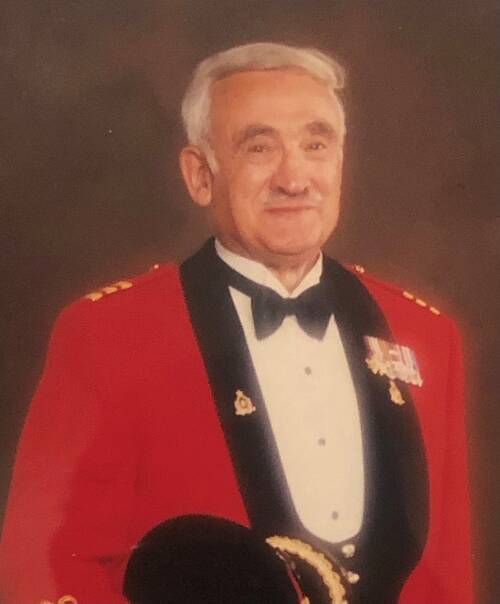 "B.J. Finestone, an honorary colonel of the B.C. Dragoons, was decorated for his service as an officer and a tank squadron leader during World War II. After the war, at home in Montreal, he was ever mindful of the challenges that maintaining a democratic way of life present. As such, he readily put his training and experiences to work wherever and whenever he saw they were needed. In Quebec and in British Columbia, he regularly met with soldiers serving in the Canadian Forces. Security was of utmost concern to BJ.
"B.J. Finestone, an honorary colonel of the B.C. Dragoons, was decorated for his service as an officer and a tank squadron leader during World War II. After the war, at home in Montreal, he was ever mindful of the challenges that maintaining a democratic way of life present. As such, he readily put his training and experiences to work wherever and whenever he saw they were needed. In Quebec and in British Columbia, he regularly met with soldiers serving in the Canadian Forces. Security was of utmost concern to BJ.
In uniform or out, he served his country, community and family with distinction. Canadians are forever grateful for the steadfastness shown by Colonel Finestone in defence of the values of freedom."
- Marc Garneau, address in Parliament February 2014
Interview with Colonel B.J. Finestone by member Erica Fagen, October 2007
Among our museum artifacts are the ID tags of Captain Finestone that he wore throughout WWII. For more information, please scroll to B.J Finestone’s story of the tags, in his own words, as shared with Terry Lightman, Museum curator in 1990.
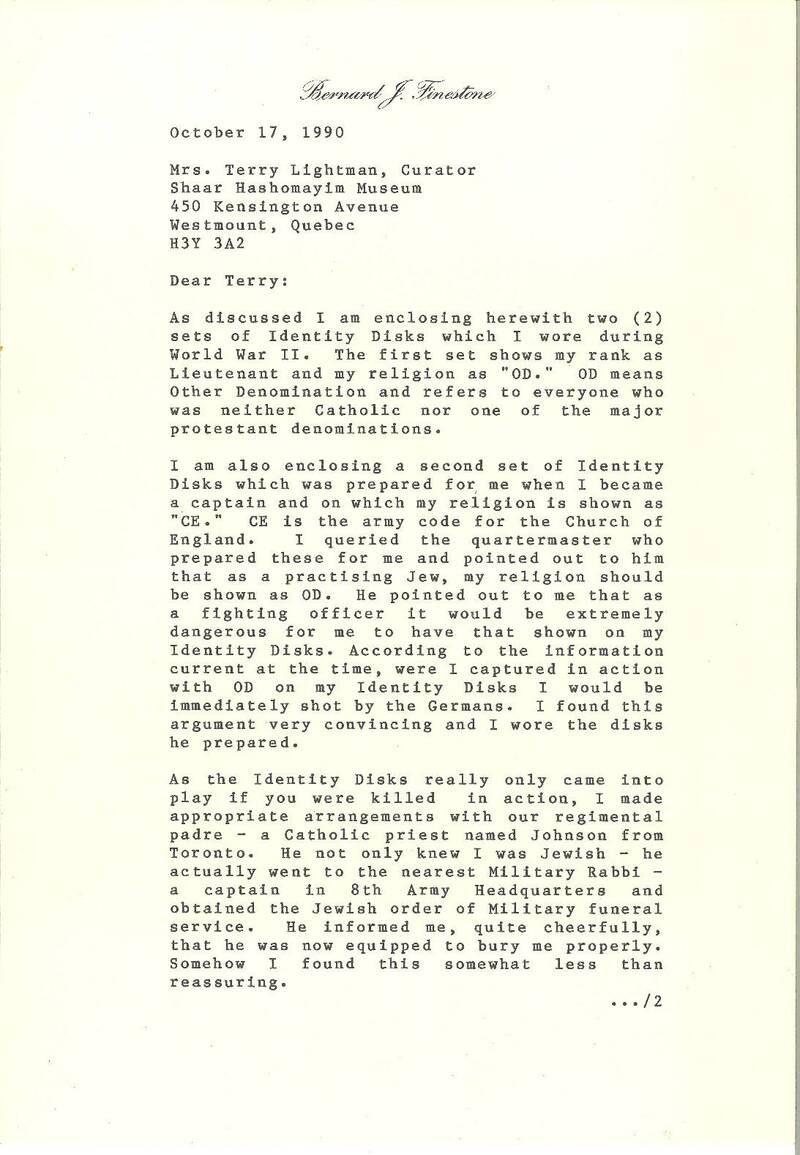
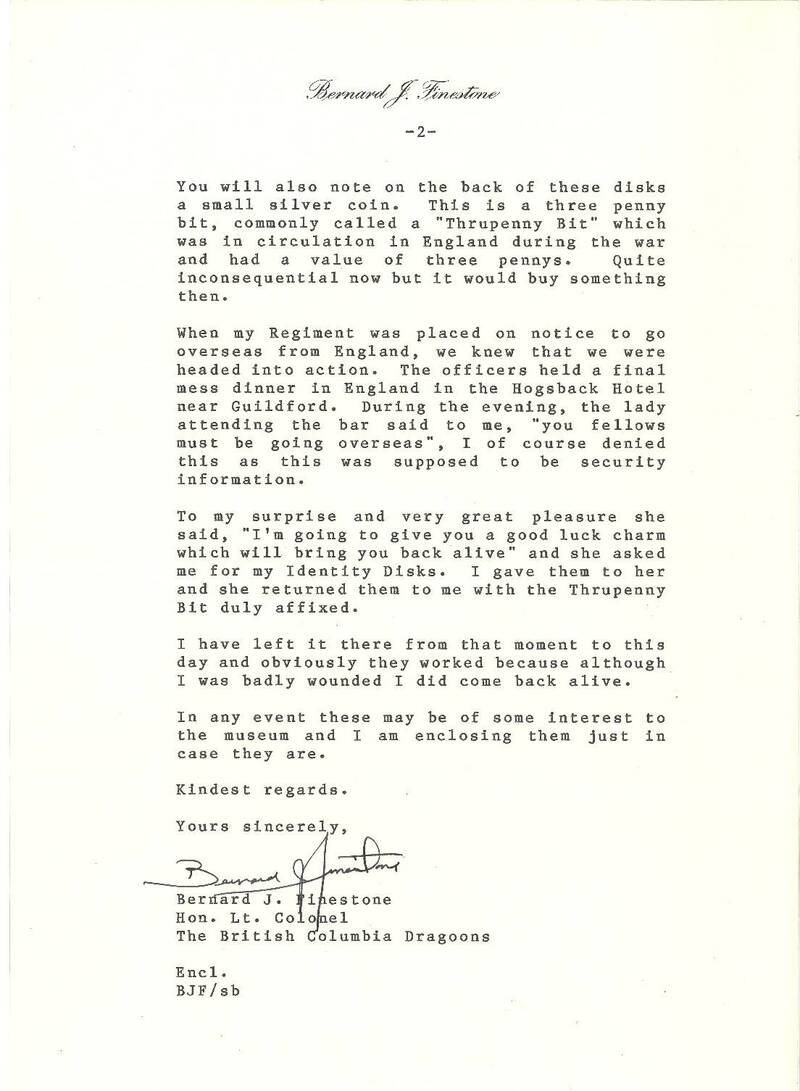
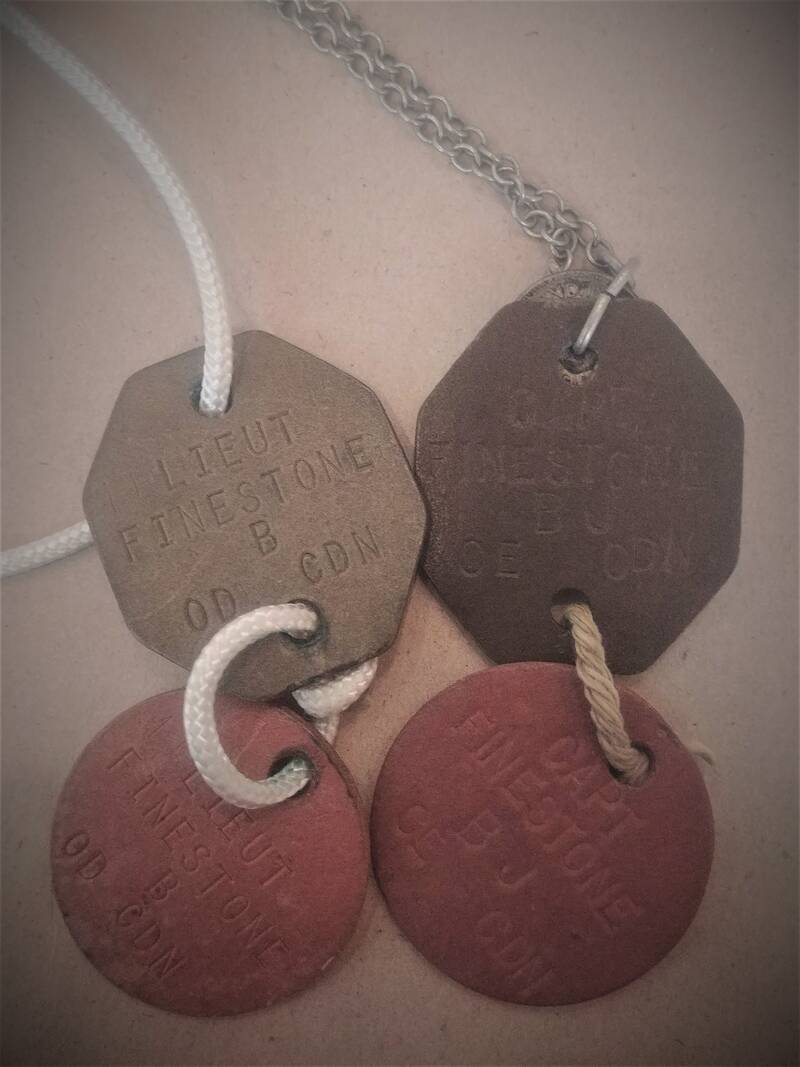
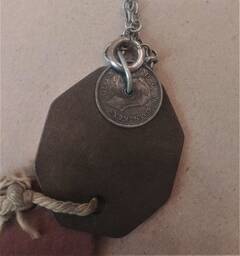
RABBI HERMAN ABRAMOWITZ AND JEWISH CHAPLAINCY SERVICES DURING WORLD WAR II
BY HANNAH SROUR
| Author | |
| Date Added |
With Remembrance Day coming up soon on November 11th, over the next few weeks the archives will feature some interesting and relevant highlights from our collections!
Rabbi Herman Abramowitz and Jewish Chaplaincy Services During World War II

Congregation Shaar Hashomayim’s spiritual leader from 1903 to 1947, Rabbi Dr. Herman Abramowitz, served as chaplain to Canadian Jewish soldiers during World War I. Some rediscovered documents in the Congregation’s archives now shed some light on Rabbi Abramowitz’s service on the Canadian Jewish Congress’s Religious Welfare Committee during the Second World War.
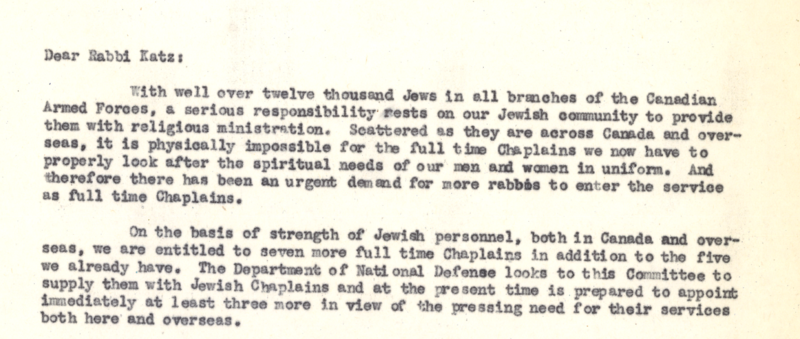
As chairman, he oversaw the religious needs of Jewish Canadian soldiers and, above all, selected Jewish chaplains for the Canadian Armed Forces. The Committee faced some distinct challenges. For one, the Committee was at first uncertain where Jewish chaplains would sit in the overall chaplaincy structure of the army. Another issue the Committee addressed at its formation in 1942 was the structure of chaplaincy appointments: where chaplains should be placed, and the expected time commitment of the position. The geographic vastness of Canada and the large number of Canadian soldiers overseas complicated matters. After much deliberation, the proposed solution was to install multiple part-time chaplains across the country (and some full-time chaplains), and appoint Rabbis Samuel Cass (later the director of Hillel at McGill until 1967) and Gershon Levi (the Shaar’s then educational director) as the senior-level full-time Jewish chaplains at home and overseas.

The Committee met on a regular basis to discuss the matter of these appointments, the work of individual chaplains, and any concerns that arose, such as the publication and distribution of religious materials for Jewish soldiers and the accessibility of kosher food.
Rabbi Abramowitz and his colleagues maintained a regular correspondence with the Committee’s sister organization in the United States—the Jewish Welfare Board’s Committee on Religious Activities, chaired by David de Sola Pool—which oversaw the appointment of Jewish chaplains for the American Armed Forces. Rabbi Abramowitz also kept Jewish Theological Seminary chancellor Dr. Louis Finkelstein informed on the activities of the Committee and sought, at times, his recommendations for chaplains. In one particularly notable letter, Dr. Finkelstein and Rabbi Abramowitz discuss the potential appointment of Rabbi Shuchat to a chaplaincy role. Regrettably, 24-year-old Rabbi Shuchat was two years younger than the minimum age (26) to serve as a chaplain.
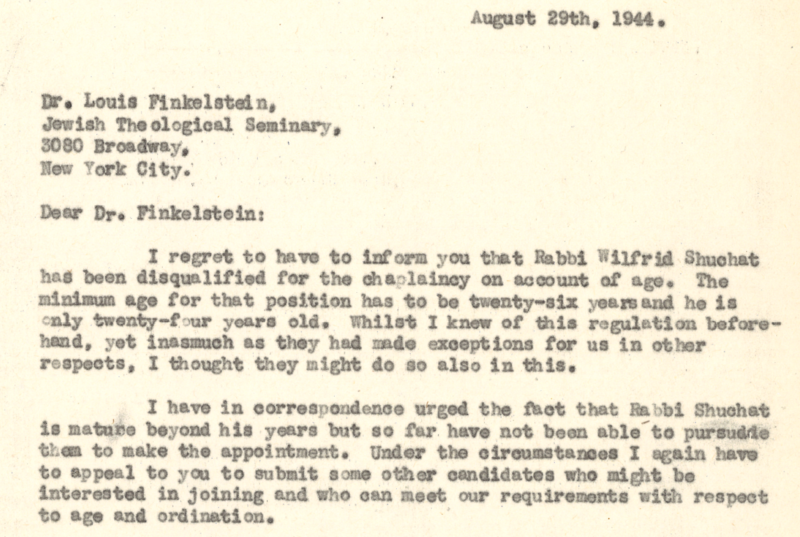
For a more in-depth look into the activities of Rabbi Abramowitz and the Religious Welfare Committee during World War II, see the excerpts below.
CLICK TO READ THE EXCERPTS
A YOM KIPPUR WAR MESSAGE FROM RABBI SHUCHAT
BY HANNAH SROUR
| Author | |
| Date Added |

“Yom Kippur will never be the same again,” begins a message written by Rabbi Wilfred Shuchat in 1973. This past week, on October 6th, marked the 48th anniversary of the outbreak of the Yom Kippur War, one of the greatest threats to the State of Israel since its independence in 1948. There to bear witness to the conflict was none other than Rabbi Shuchat, who wrote back messages to the Congregation as it unfolded (full letters at the end).
Rabbi Shuchat was honoured with a sabbatical soon after celebrating 25 years with Shaar Hashomayim and went with his family to spend the year (from July 1973 through the summer of 1974) in Jerusalem. Though Rabbi Shuchat returned to Montreal for Rosh Hashanah and Yom Kippur, he went back to an Israel embroiled in war.

The words Rabbi Shuchat wrote in his messages to the Congregation as the Yom Kippur War progressed deeply reflect the severity of the situation, while also foreseeing its lasting impact and significance. “For the past two weeks I have been living in the very center of those dramatic events that will determine Jewish history for the future and will certainly have a momentous effect upon the course of the world.”

Writing on October 23rd, 1973, just two days before it officially came to an end, Rabbi Shuchat offered three conclusions to be drawn from the War as Israel, the Jewish Diaspora, and the world moves forward, the third of which is a resounding and heartfelt declaration of the bond between Israel and the Diaspora as one Jewish people.

READ: A message from Rabbi Shuchat, War Letter from Israel
From the Rabbi Wilfred Shuchat Archives, Congregation Shaar Hashomayim
Get in touch with us! Claire Berger and Hannah Srour at museum@theshaar.org
SUKKOT
BY HANNAH SROUR
| Author | |
| Date Added |
As we head into Sukkot, amid the rush to put up and decorate their sukkahs, many Jews will also be pulling out their etrog boxes. Since the etrog must be in near-perfect condition and is rendered unusable on the holiday if damaged, these boxes prove useful in maintaining the beautiful condition of the fruit. Their designs range from simple to intricate, signifying and enhancing the beauty of the etrog itself, as a form of ḥiddur mitzvah (‘beautification of a mitzvah’). The Shaar Hashomayim Museum collection contains a number of elegant historical and contemporary etrog boxes.
Etrog Box: Silver (800), gilt lined, patterned and pomegranate design on top. Galicia, Austria (southeastern Poland and western Ukraine), c. 1890. Purchased 1987. Photograph by Daniel Zackon.
Etrog Box: Origin unknown. Gift of Mrs. Freda Cohen in memory of Ann Bronfman, May 28, 1981. Photograph by Daniel Zackon.
Etrog Box: Heavy silver (800), filigree, shape of peacock or mythical bird. The stomach opens to permit the etrog to be placed inside. Middle East, late 19th C. Donated by estate of Gertrude Lande Denbow, 1980. Photograph by Daniel Zackon.
These three etrog boxes, each made of silver, show an interesting range in etrog holder design. While the origin of one of the boxes is unknown, the others were produced in different parts of the Jewish world—Eastern Europe and the Middle East. The first box is designed to appear as an etrog itself, as seen in the gilded pattern and the pitom (stem) at the top. The second box, which has a more common design, resembles a jewelry box, indicating the great value of the contents it is intended to protect. Especially unique, though, is the peacock design, which is a common motif in Jewish art. The craftsmanship is complicated and intricate: the bird is largely filigreed—a notably difficult and delicate form of metalwork which is lace-like in its appearance. This, of course, renders the box partially transparent. When an etrog is placed in this box, the sophisticated design would surround the fruit—making it appear like a crown jewel!
Chag sameach!
Get in touch with us! Claire Berger and Hannah Srour at museum@theshaar.org
ROSH HASHANAH
BY HANNAH SROUR
| Author | |
| Date Added |
Photograph taken by Daniel Zackon
As we continue to sort through the Shaar’s vast and rich collections, this week we feature some fascinating Rosh Hashanah-related artifacts from the museum.
This beautiful shofar (originally from Yemen) was presented to the Congregation by then-Israeli President Chaim Herzog on the occasion of his first State visit to Canada on June 28, 1989 (25 Sivan, 5749). Chaim Herzog—the father of the current President of Israel, Isaac Herzog—visited the synagogue on a Wednesday night to a well-attended evening of over 2,000 people. While some sources claim that this was the first official visit by an Israeli President to Canada, this is not entirely true—President Zalman Shazar visited Montreal in 1967 where he opened the Pavilion of Judaism at Expo 67. In any case, this shofar, while not just exquisite, also acts as a reminder of the honour Herzog bestowed on the Synagogue with his visit.
Going back a century, this silver kiddish cup (8 ½ inches tall) was made in Montreal in the 19th century and is used each year during Rosh Hashanah services by Cantor Gideon Zelermeyer. Engraved on the cup is the following: “Presented by Louis Lewis to the German and Polish Congregation, Montreal, September 22nd, 1892, Tishri 1st 5653.” Gifted back to the Congregation in 2007, the German, Polish, and English Congregation was the original name of Shaar Hashomayim before its present name was adopted. Louis Lewis was a prominent member of the Synagogue; in the famous picture of the interior of the Congregation’s previous location on McGill College, he is seated towards the front near Lazarus Cohen (a past president, father of Lyon Cohen, and great-grandfather of Leonard). Lewis also served for some time as President of the Baron de Hirsh Institute. While the reasons for which he presented this kiddish cup to the Congregation on Rosh Hashanah in 1892 are unknown, it is a beautiful example of Montreal Judaica and a fascinating piece of the Shaar’s history.
INTRODUCING THE SUMMER ARCHIVAL PROJECT
BY CLAIRE BERGER
| Author | |
| Date Added |
Over the winter of 2021, Rabbi Shuchat’s file cabinets were brought out of storage and slowly the task of sifting through Rabbi Herman Abramowitz and Rabbi Wilfred Shuchat files began. Due to COVID-19 restrictions, I worked alone, passionate about preserving the Shaar’s rich history, however I quickly realized that this project would require a professional archivist. As restrictions eased and with the support of a Canada Summer Jobs, we were delighted to welcome Hannah Srour, a recent graduate of the Master of Information program at the University of Toronto, where she concentrated in Archives & Library Science.
Since joining the Shaar at the end of June, she along with my guidance and the volunteer help of Aviya Scheier and Kinneret Finegold have uncovered many exciting finds among Rabbi Shuchat's papers, including personal letters from Abraham Heschel, A. M. Klein, and Chaim Potok, records about Leonard Cohen's youth involvement at the synagogue, and various materials related to the Pavilion of Judaism at Expo '67 to name but a few.
Follow us in the Shaar’s enewsletter as we continue to share our discoveries and ask for your help in piecing together more of our Shaar’s history.
Claire Berger - museum@theshaar.org
Back to top
Wednesday, October 22, 2025
30 Tishrei 5786
OTHER ARTICLES
Telephone
514.937.9471
Fax
514.937.2067
admin@theshaar.org
Privacy Settings | Privacy Policy | Member Terms
©2025 All rights reserved. Find out more about ShulCloud


